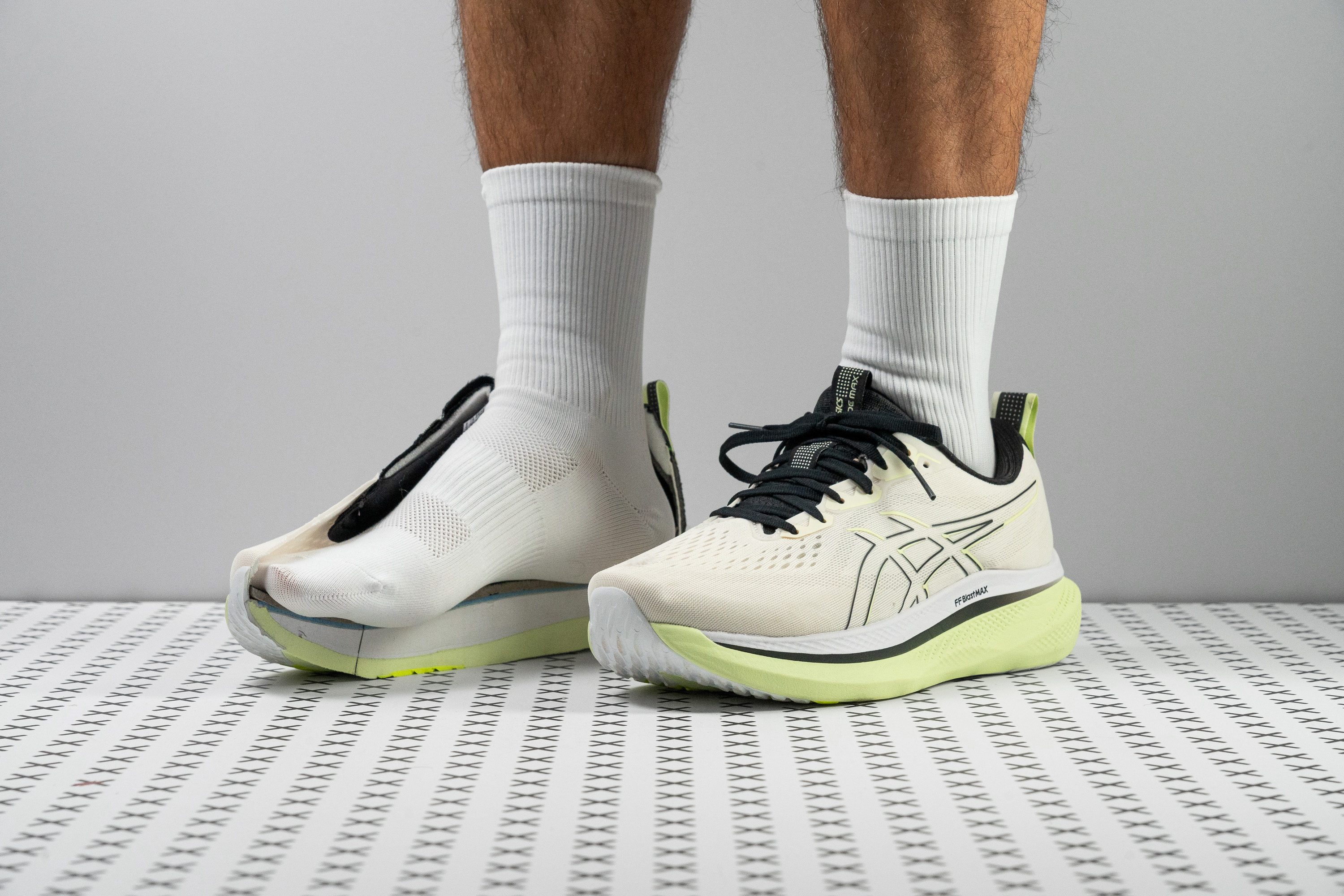Our verdict
Pros
- Tonnes of cushioning!
- Smooth rockered ride
- Secure and well-built upper
- No heel slippage
- Feels lighter than its stack suggests
- Fantastic for high-mileage training
- Optimised for heel strikers
- Somewhat stable despite its size
- World-class grip
Cons
- Pricey for its performance
- Stiffer build limits comfort
- Not the best for walking
- Needs more energy return
Audience verdict
- Top 6% in road running shoes
- Top 9% in ASICS running shoes
Comparison
The most similar running shoes compared
+ + Add a shoe | |||||
|---|---|---|---|---|---|
| Audience score | 92 Superb! | 90 Superb! | 83 Good! | 86 Good! | |
| Price | £160 | £210 | £185 | £180 | |
| Pace | Daily running | Daily runningTempo | Daily running | Daily running | |
| Shock absorption | High | Moderate | Moderate | High | |
| Energy return | Low | High | Moderate | Low | |
| Traction | High | High | Moderate | High | |
| Arch support | Neutral | Neutral | Neutral | Neutral | |
| Weight lab Weight brand | 9.9 oz / 281g 10.2 oz / 289g | 8.9 oz / 252g 8.8 oz / 250g | 11.4 oz / 322g 11.7 oz / 333g | 10.5 oz / 299g 10.8 oz / 305g | |
| Drop lab Drop brand | 12.7 mm 6.0 mm | 8.2 mm 8.0 mm | 8.6 mm 8.0 mm | 8.3 mm 8.0 mm | |
| Strike pattern | Heel | HeelMid/forefoot | HeelMid/forefoot | HeelMid/forefoot | |
| Size | Slightly small | True to size | True to size | True to size | |
| Midsole softness | Soft | Soft | Soft | Balanced | |
| Difference in midsole softness in cold | Small | Small | Small | Small | |
| Toebox durability | Decent | Good | Decent | Decent | |
| Heel padding durability | Good | Good | Decent | Good | |
| Outsole durability | Good | Good | Good | Good | |
| Breathability | Moderate | Breathable | Moderate | Moderate | |
| Width / fit | Medium | Medium | Medium | Medium | |
| Toebox width | Medium | Medium | Medium | Medium | |
| Stiffness | Moderate | Stiff | Moderate | Stiff | |
| Torsional rigidity | Stiff | Stiff | Stiff | Stiff | |
| Heel counter stiffness | Stiff | Moderate | Stiff | Stiff | |
| Rocker | ✓ | ✓ | ✓ | ✓ | |
| Heel lab Heel brand | 44.1 mm 44.0 mm | 42.8 mm 45.0 mm | 38.8 mm 38.0 mm | 42.7 mm 44.0 mm | |
| Forefoot lab Forefoot brand | 31.4 mm 38.0 mm | 34.6 mm 37.0 mm | 30.2 mm 30.0 mm | 34.4 mm 36.0 mm | |
| Widths available | NormalWide | NormalWide | Normal | NormalWideX-Wide | |
| Orthotic friendly | ✓ | ✓ | ✓ | ✓ | |
| Season | All seasons | SummerAll seasons | All seasons | All seasons | |
| Removable insole | ✓ | ✓ | ✓ | ✓ | |
| Ranking | #16 Top 5% | #74 Top 20% | #268 Bottom 27% | #174 Top 48% | |
| Popularity | #132 Top 36% | #25 Top 7% | #297 Bottom 19% | #18 Top 5% |
Who should buy
After pushing the Glideride Max to its limits, we believe it's best suited for:
- Runners prioritising ultimate muscle and joint protection for easy to moderate paces, even if it means spending a bit more.
- Heel strikers seeking a plush-yet-stable daily trainer with excellent impact absorption.
- Marathoners wanting a long-run workhorse that keeps legs fresh for faster training days.
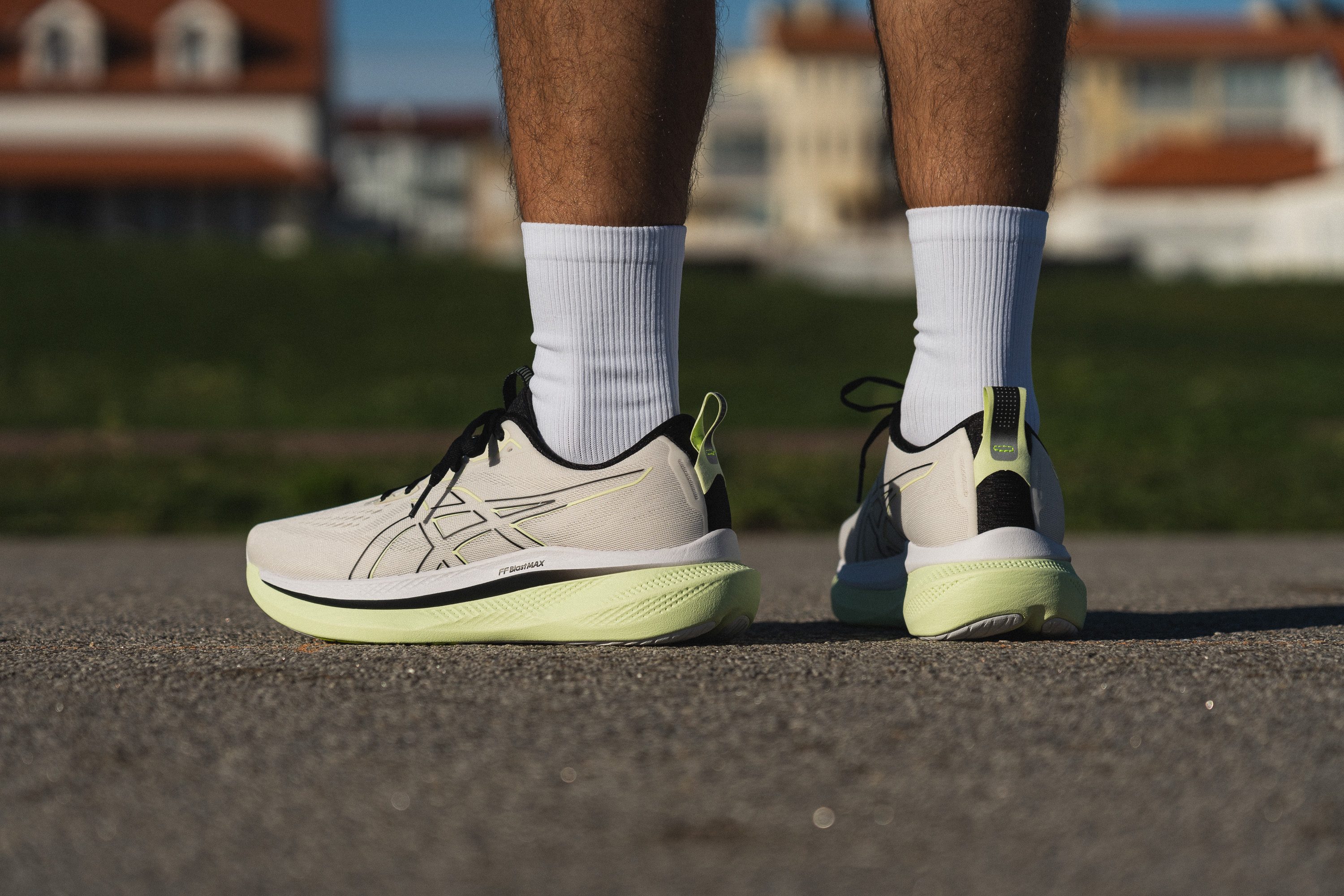
Who should NOT buy
We believe the ASICS Glideride Max’s steep price makes it a hard sell as a daily trainer, especially when the ASICS Novablast 5 delivers a similarly cushioned ride with a full FF Blast Max midsole, lower weight, and a lower price.
Additionally, we found that the Glideride Max lacks the agility needed for handle speedwork. Its stiff construction and towering stack make it less suitable for faster paces, leaving it feeling sluggish. If versatility is a priority, we strongly recommend looking at the Adidas Adizero EVO SL or the Hoka Mach 6—both of which are lighter, more responsive, and easier on your wallet.
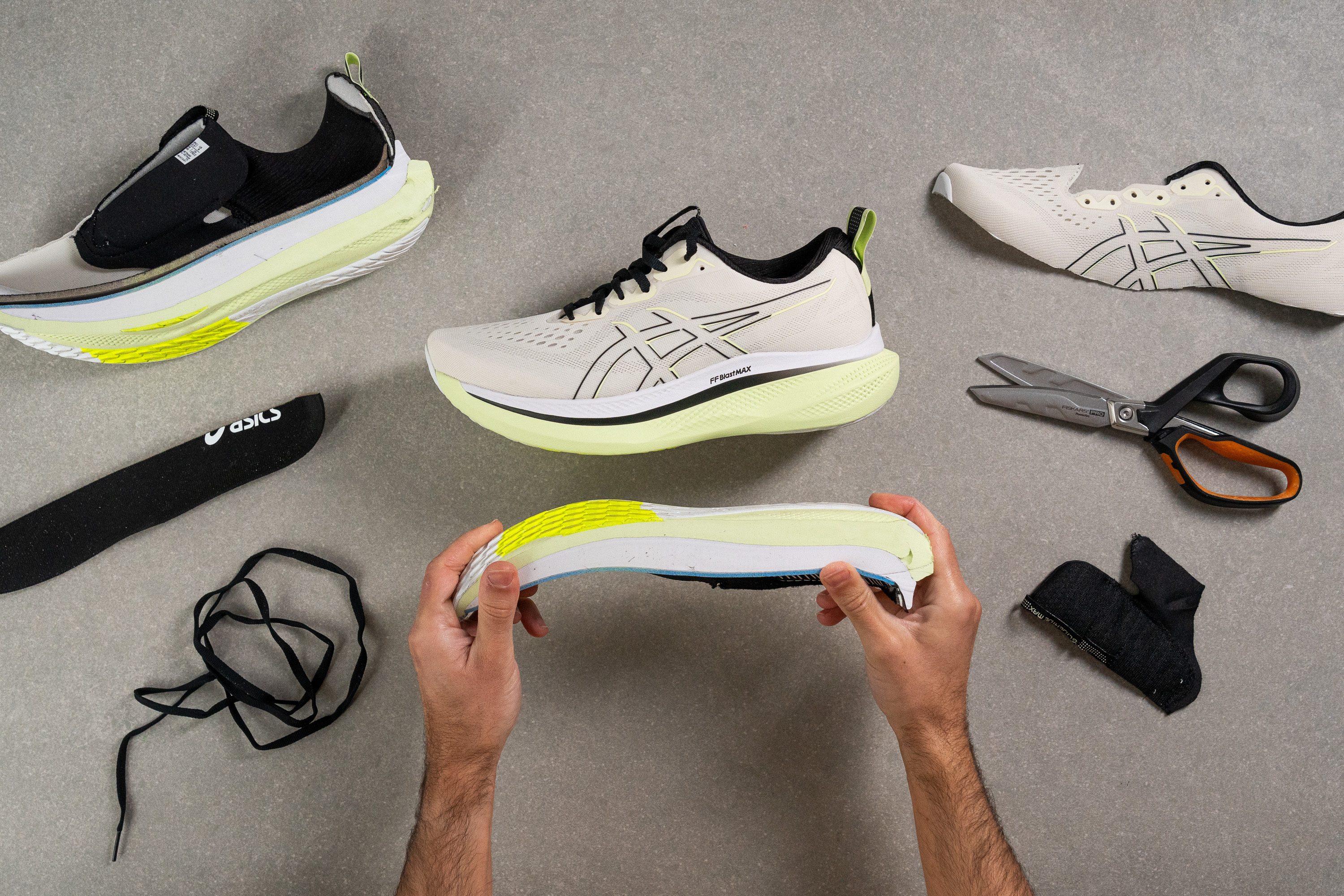
Cushioning
Shock absorption
The Glideride Max lives up to its name with a super-cushioned midsole that delivers max impact protection, reaching 143 SA in the heel and a solid 123 SA in the forefoot.
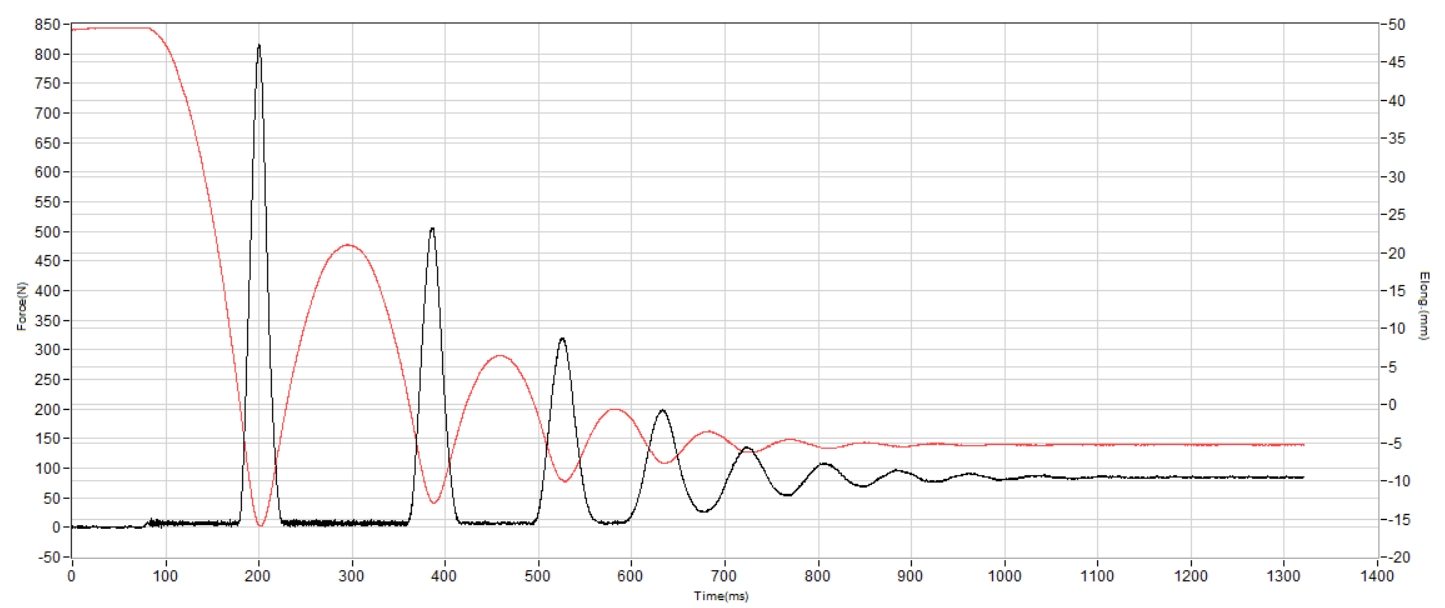
| Glideride Max | 143 SA |
| Average | 129 SA |
Energy return
With just 51.9% energy return, the Glideride Max falls short for runners chasing performance. It handles slow-paced efforts and the occasional pickup, but for a fast ride, it’s far off—and it's especially dramatic with its high price point.
| Glideride Max | 51.9% |
| Average | 58.6% |
Heel stack
The Glideride Max lives up to its name with an astonishingly high 44.1 mm heel stack. That's perfect for runners seeking top-tier muscle protection. In our view, this maximalist design also makes it one of the best choices in the market for heavier individuals running on pavement.
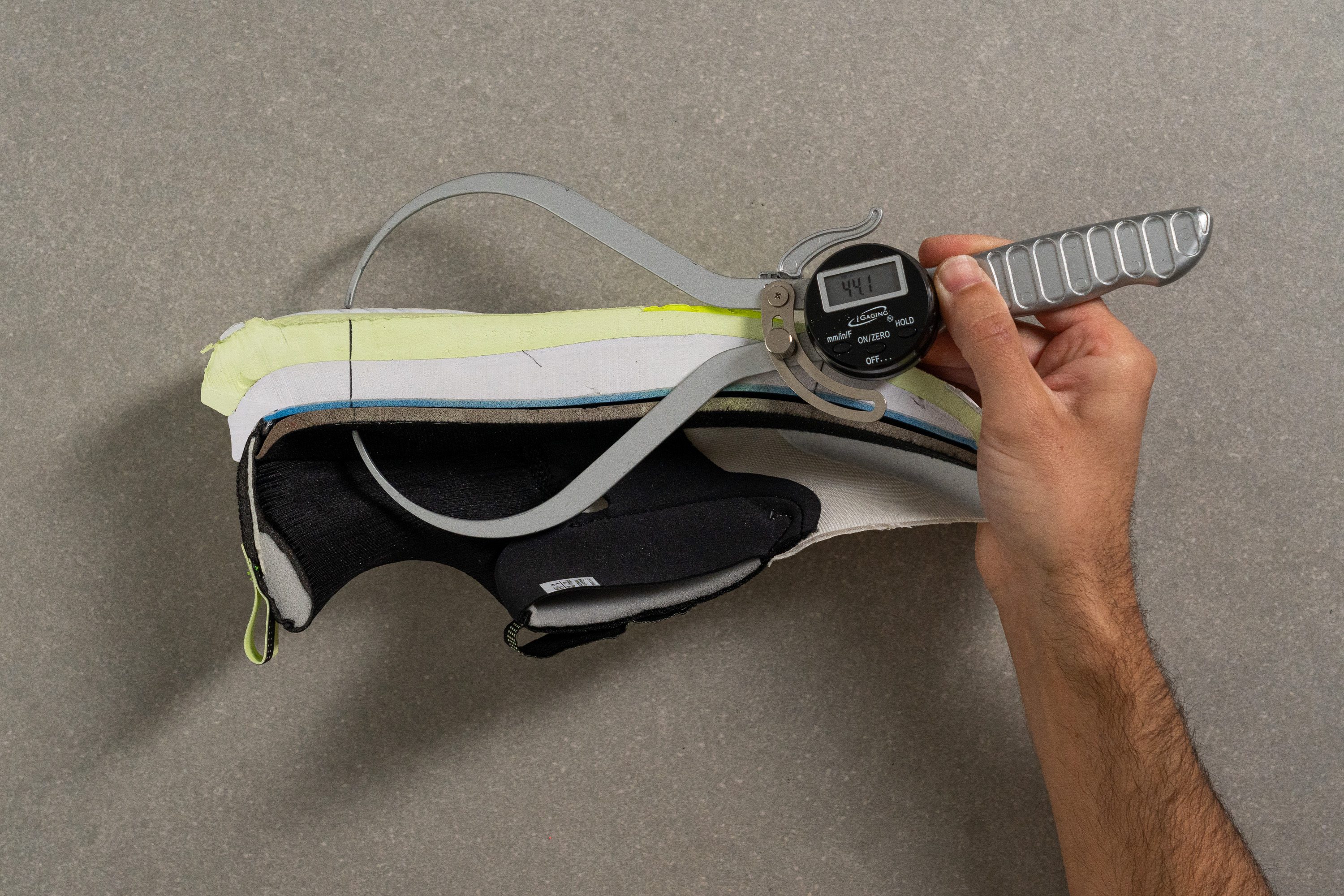
| Glideride Max | 44.1 mm |
| Average | 34.7 mm |
Forefoot stack
While the heel matched ASICS’ official specs (44/38 mm), we discovered that the forefoot, though still ultra-cushioned, measured noticeably shorter under our callipers at just 31.4 mm.
But why the discrepancy? We followed World Athletics’ measurement guidelines, as we do for every shoe, but in our view, ASICS may have measured the forefoot slightly closer to the midfoot than we did.
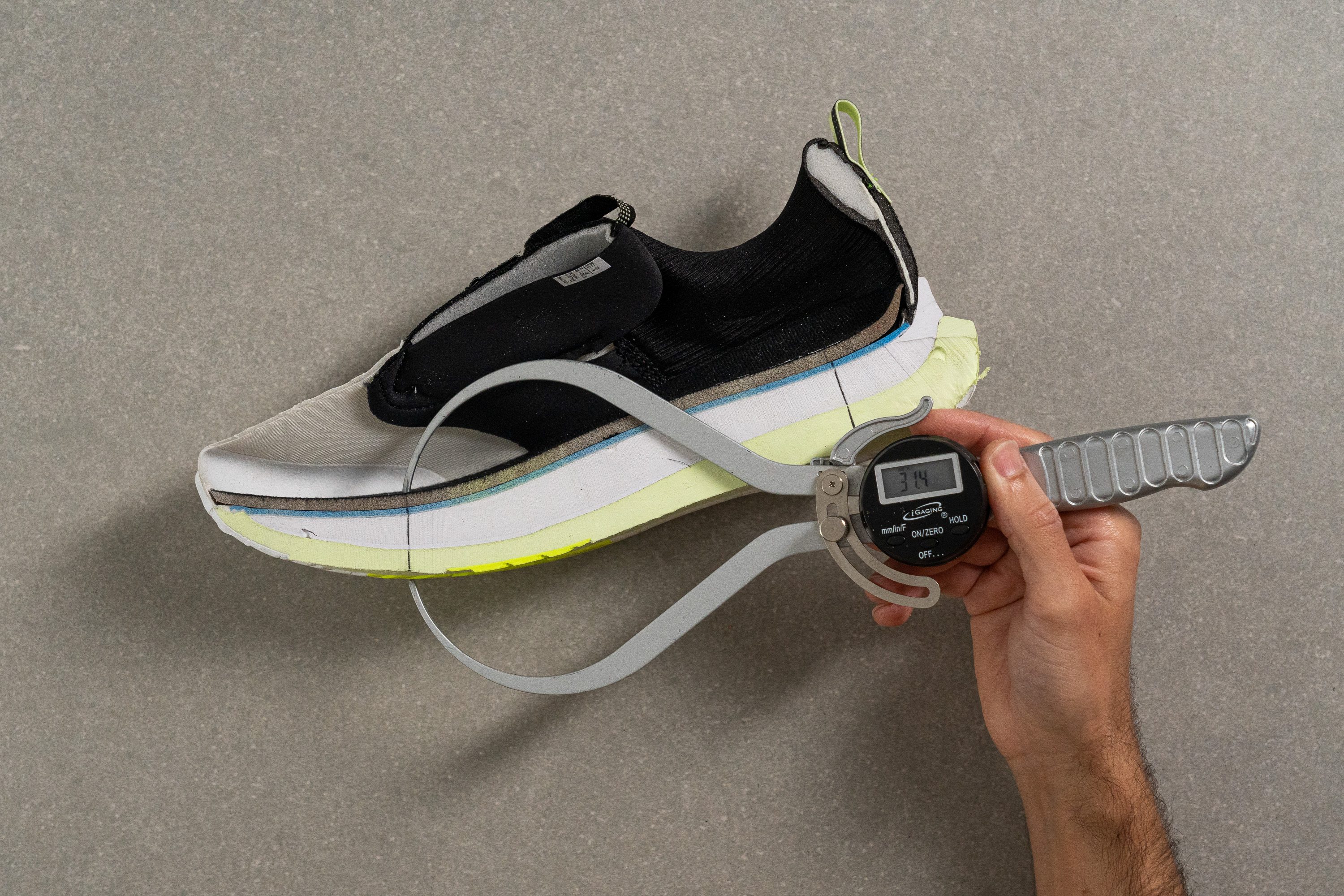
| Glideride Max | 31.4 mm |
| Average | 26.1 mm |
Drop
That naturally affects the stated 6 mm drop, revealing a true 12.7 mm drop based on our measurements. However, with its pronounced toe spring, the Glideride Max feels while running more like an 8 or 10 mm drop rather than 6 or 12.7 mm.
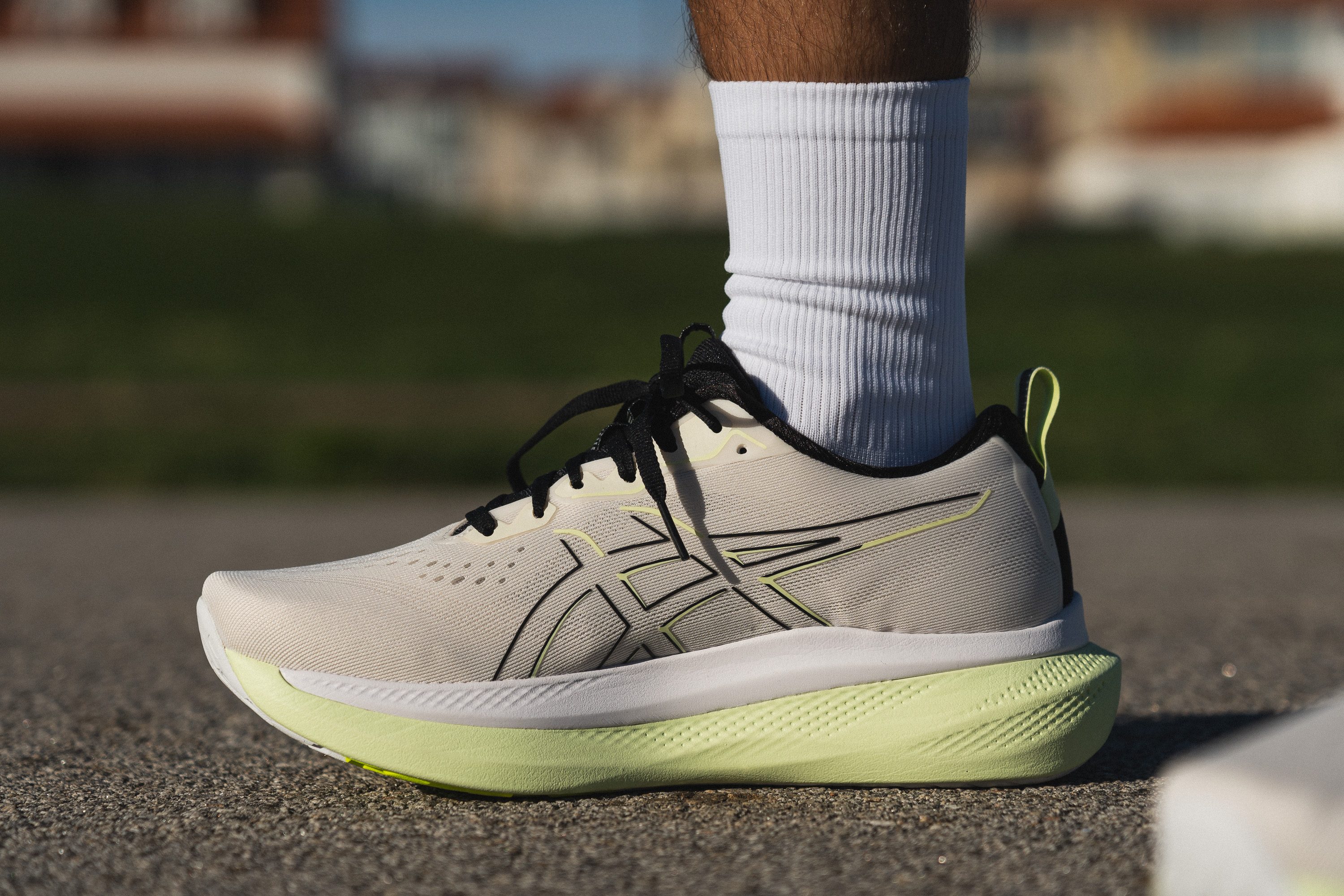
| Glideride Max | 12.7 mm |
| Average | 8.6 mm |
Midsole softness
The Glideride Max gets its name from its core cushioning—FF Blast Max.
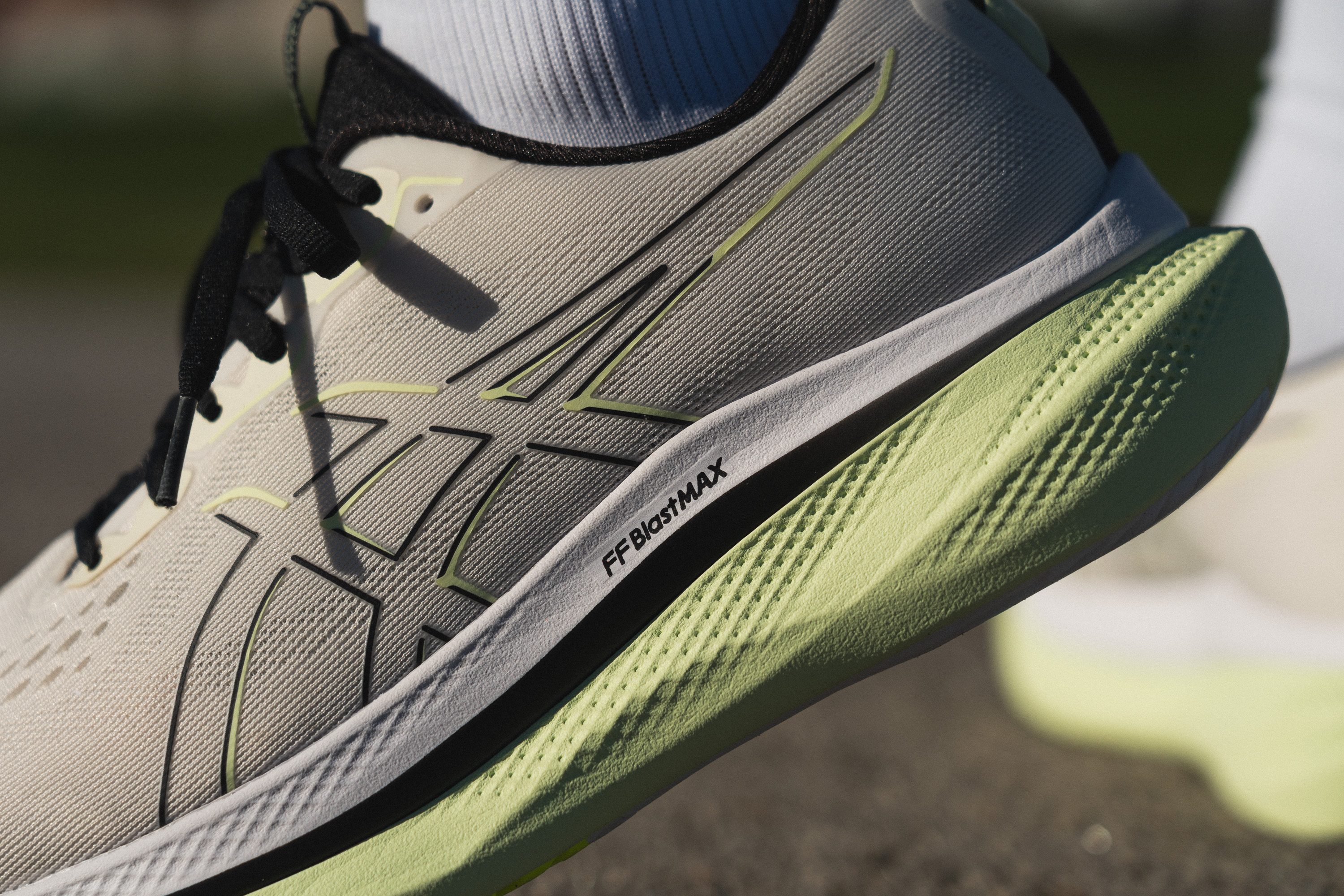
This ASICS foam appears in other models, but it made its debut in the Glideride Max, and we have to say—it delivers exactly what it promised: an upgraded version of FF Blast+ ECO that improves in every way.
In terms of softness, it’s slightly plusher than FF Blast+ ECO at 17.8 HA and offers a modest boost in energy return, though nothing groundbreaking. In fact, if you're after an ASICS training shoe with cutting-edge midsole technology, the Superblast 2 with FF Turbo+ is the choice.
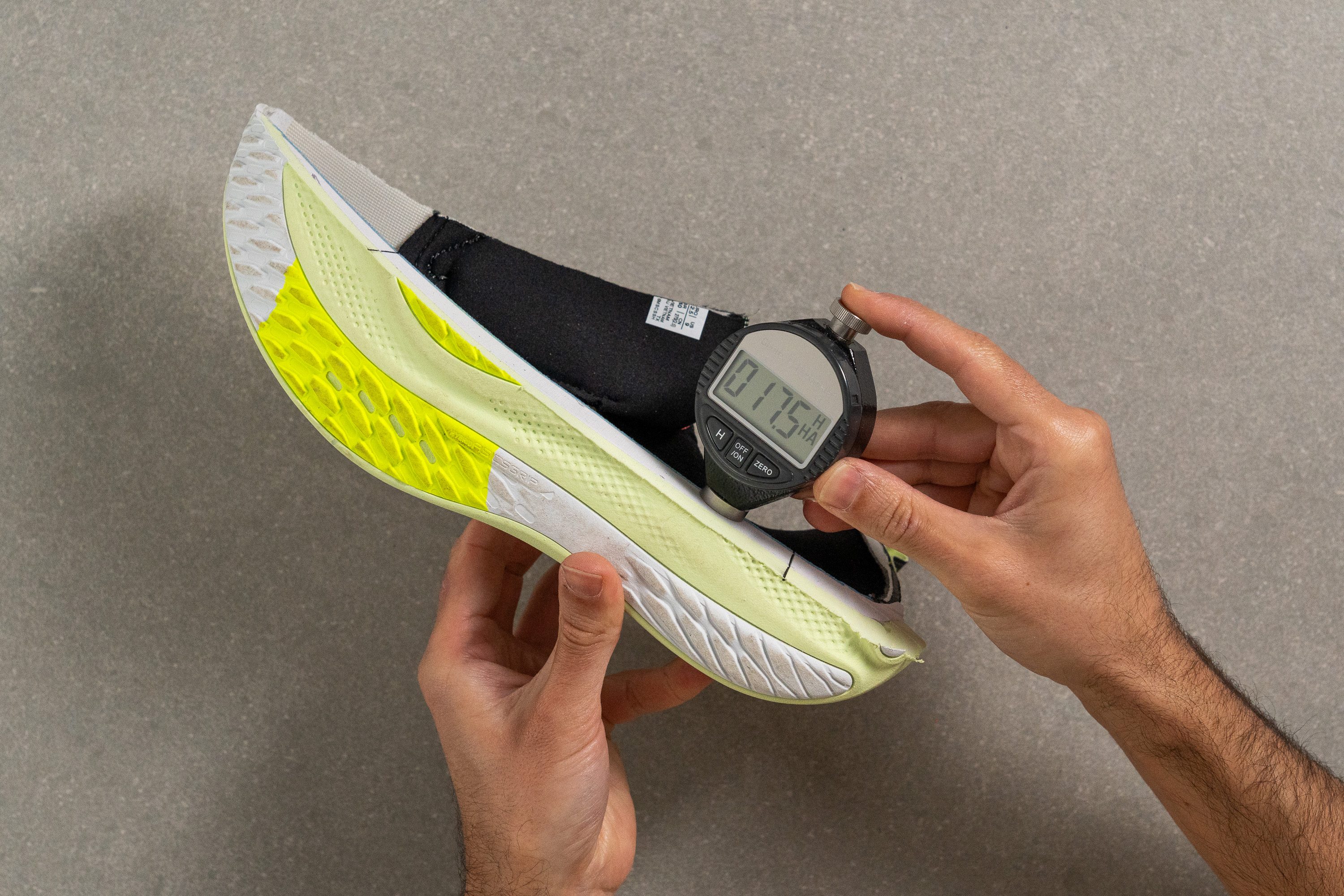
| Glideride Max | 17.8 HA |
| Average | 20.4 HA |
Secondary foam softness
The midsole isn’t fully composed of FF Blast Max—it includes a bottom layer of FF Blast+ ECO, similar to the Superblast 2. This setup helps protect the FF Blast Max compound while the slightly firmer foam (19.3 HA) provides a much-needed stability boost.
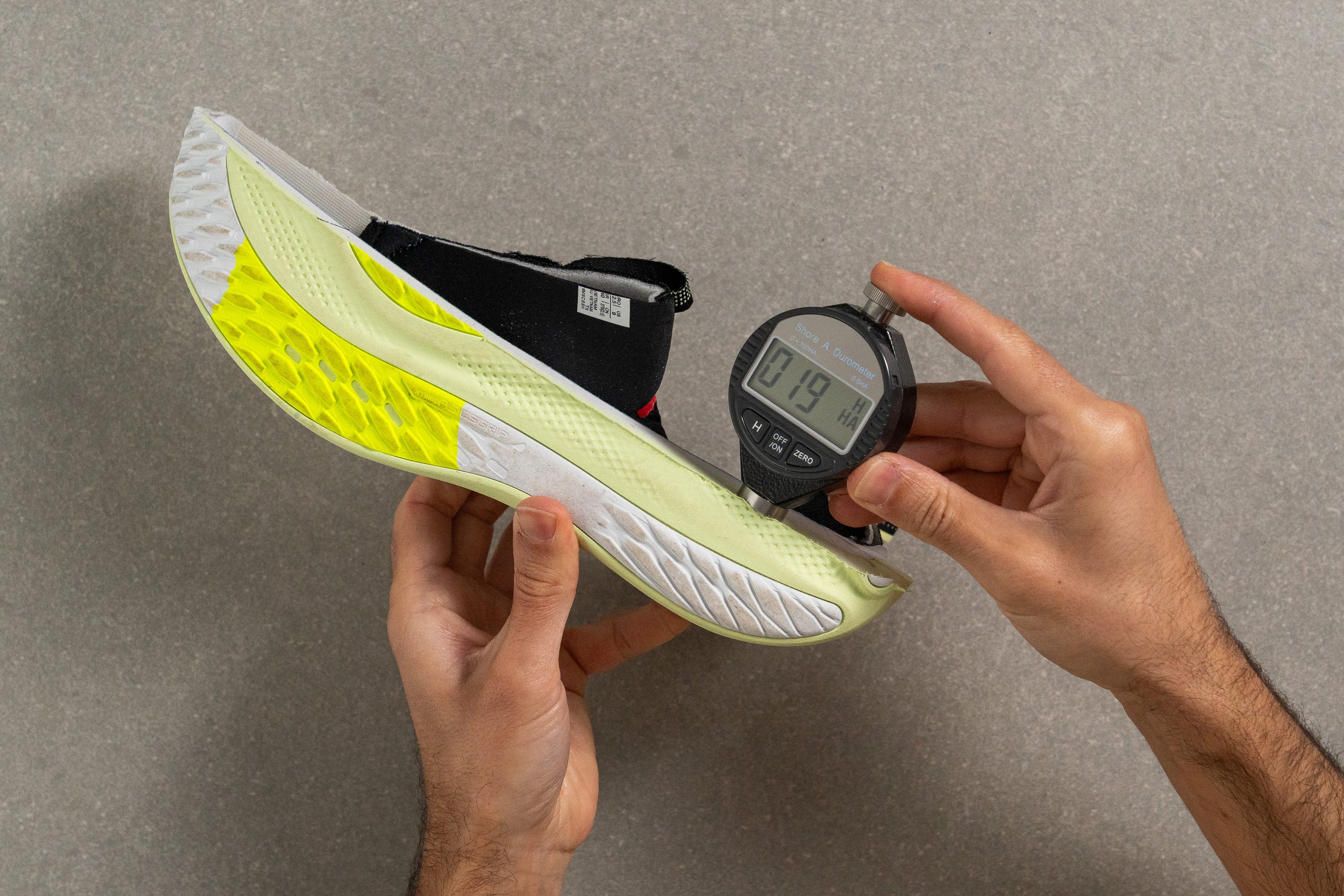
| Glideride Max | 19.3 HA |
| Average | 22.6 HA |
Rocker
One of the defining features of the Glideride series has always been its aggressively rockered sole. In fact, we believe the original GUIDESOLE design played a key role in pushing the market toward this trend.
True to its legacy, we found that the Max version takes it even further, elevating the tip of the shoe to a striking 6 cm!
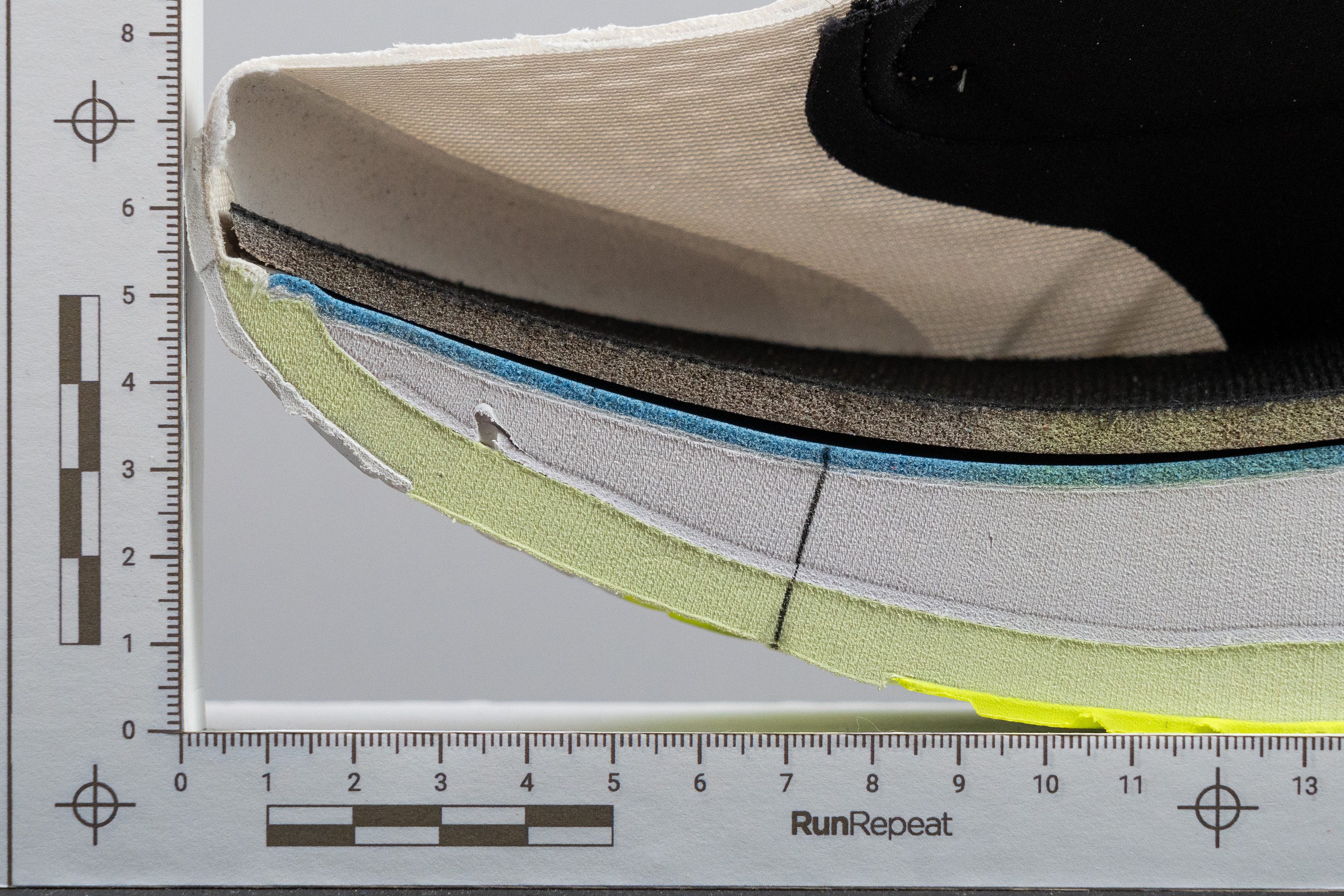
EVA Plate
One standout feature of the Glideride Max is ASICS’ use of an EVA plate embedded between both foams—but only in the midfoot and forefoot. The plate begins and ends precisely between the arrows we added (yes, it’s difficult to spot since it blends in with the white FF Blast Max foam).
This raises two key questions: what’s its purpose, and is it exclusive to ASICS? First, the EVA plate enhances stability and rigidity without the harsh stiffness of Pebax or carbon alternatives. Second, this design isn’t unique to ASICS, as models like the New Balance Fresh Foam X Vongo v6 implemented an EVA plate before.
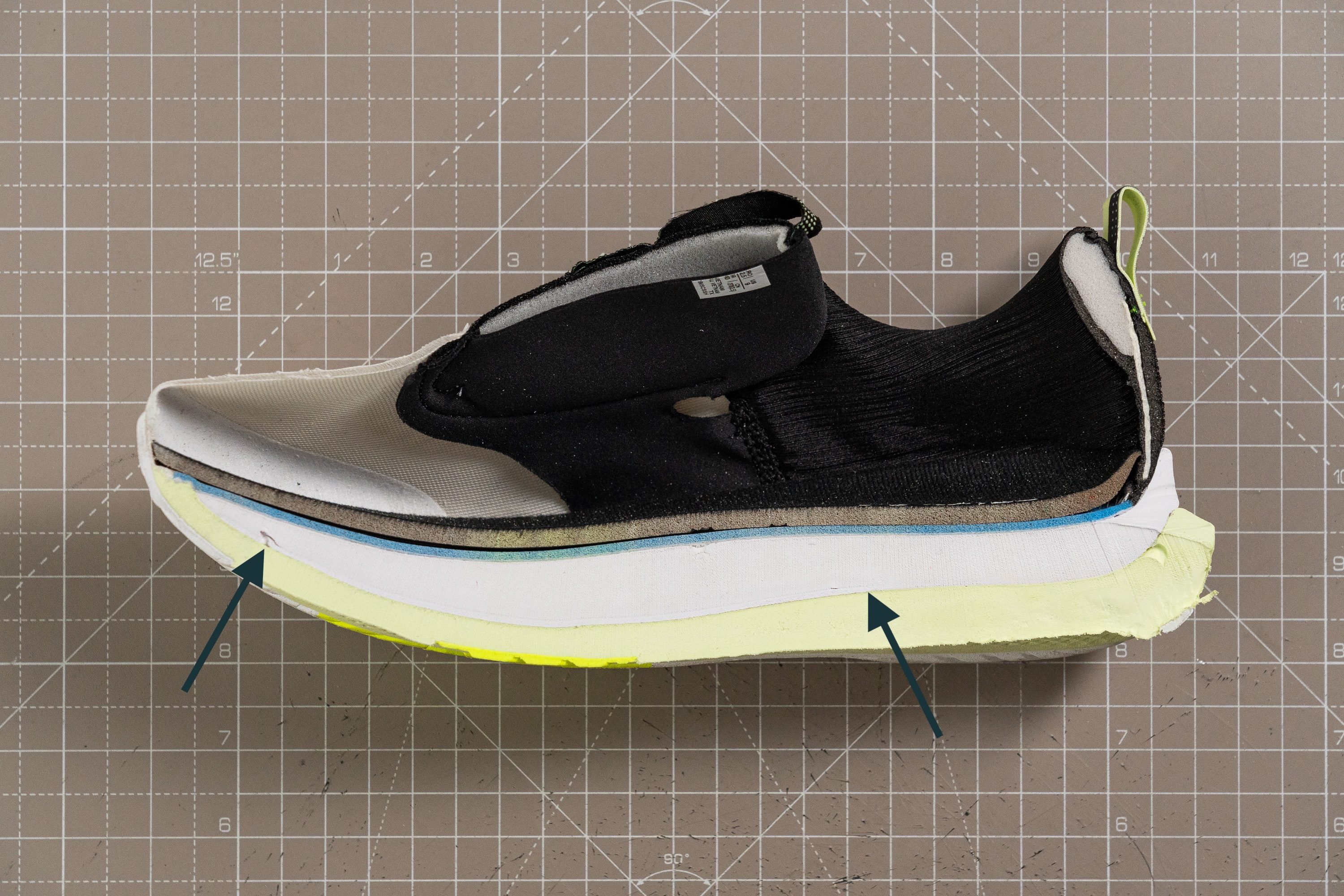
Size and fit
Size
ASICS Glideride Max fits slightly small (70 votes).
Width / Fit
ASICS tends to design well-balanced shoes that avoid extremes—neither too narrow nor overly spacious—and the Glideride Max follows this trend.
After letting our gel mould solidify in the freezer, we removed it from the shoe and began our round of precise measurements. The first reading, taken at the widest part of the upper, delivered an expected result of 95.7 mm, reinforcing its medium-width profile.
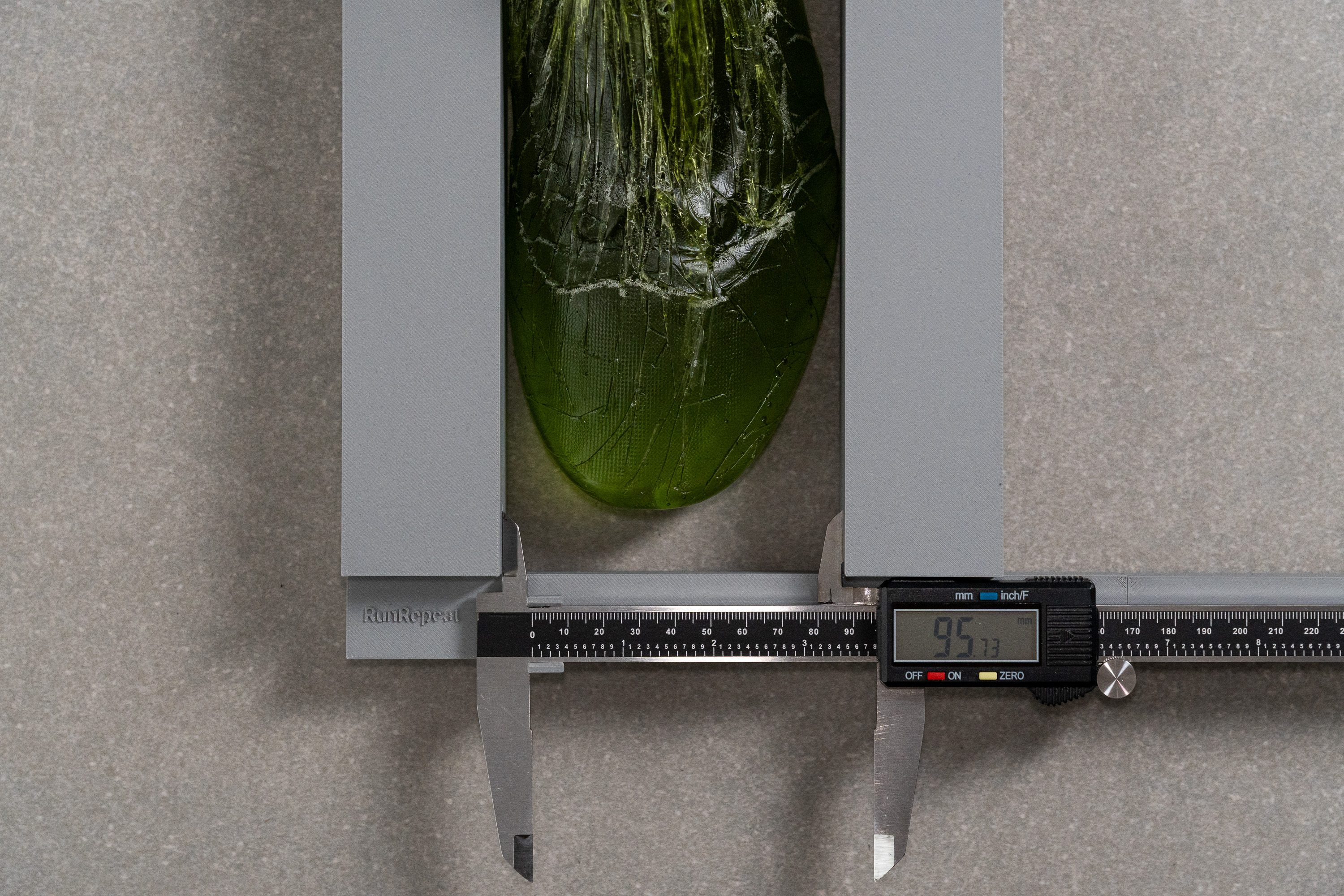
| Glideride Max | 95.7 mm |
| Average | 95.1 mm |
Toebox width
The toebox follows an average taper, as our measurement came in at 72.9 mm, delivering a well-balanced fit that felt natural on foot.
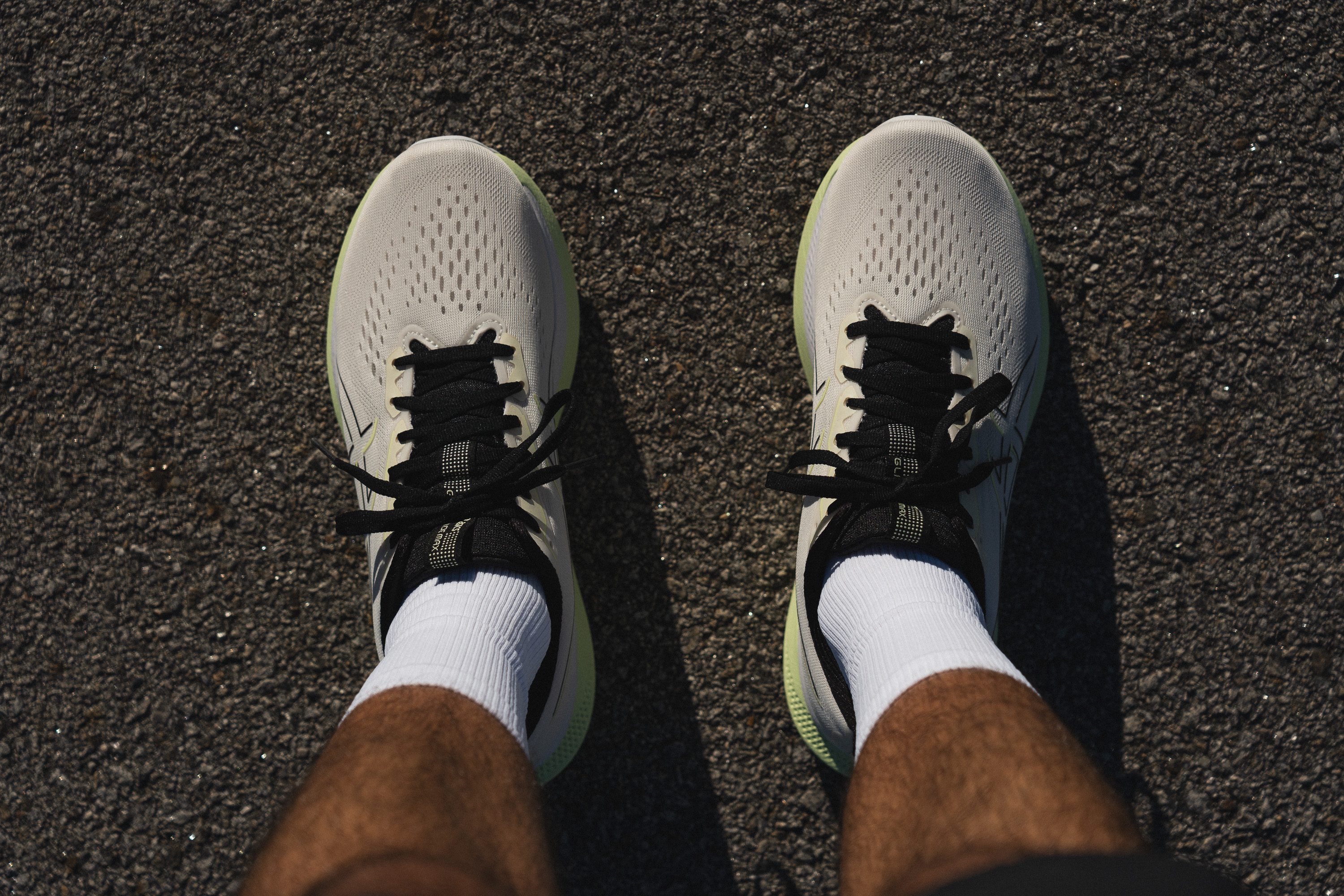
ASICS kept things pretty much standard here, but for those needing extra space, a wide size is available.
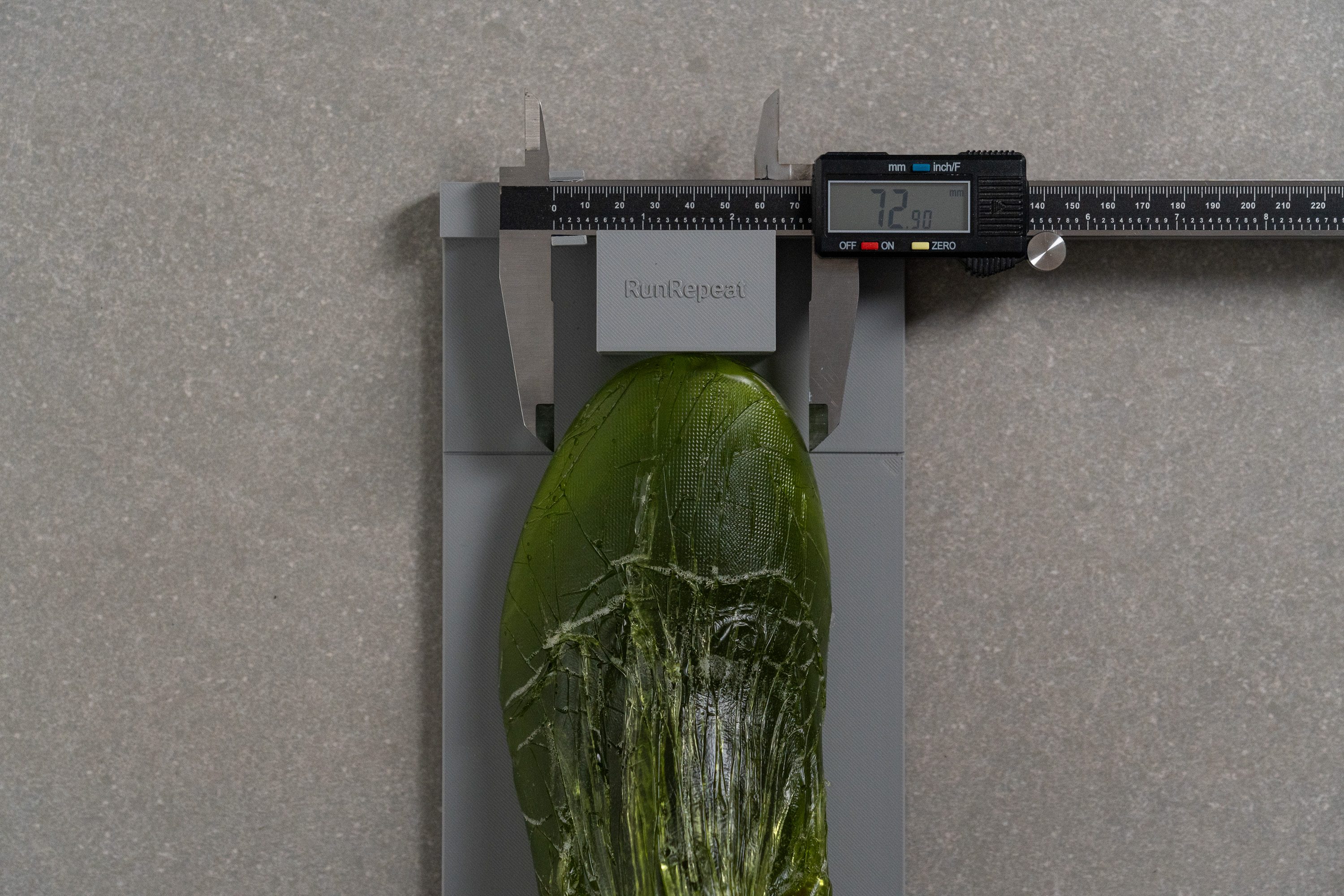
| Glideride Max | 72.9 mm |
| Average | 73.3 mm |
Toebox height
When it comes to vertical space, the Glideride Max gets our approval, offering 27.4 mm of clearance—more than enough to ensure a comfortable fit without causing any restrictions for runners.
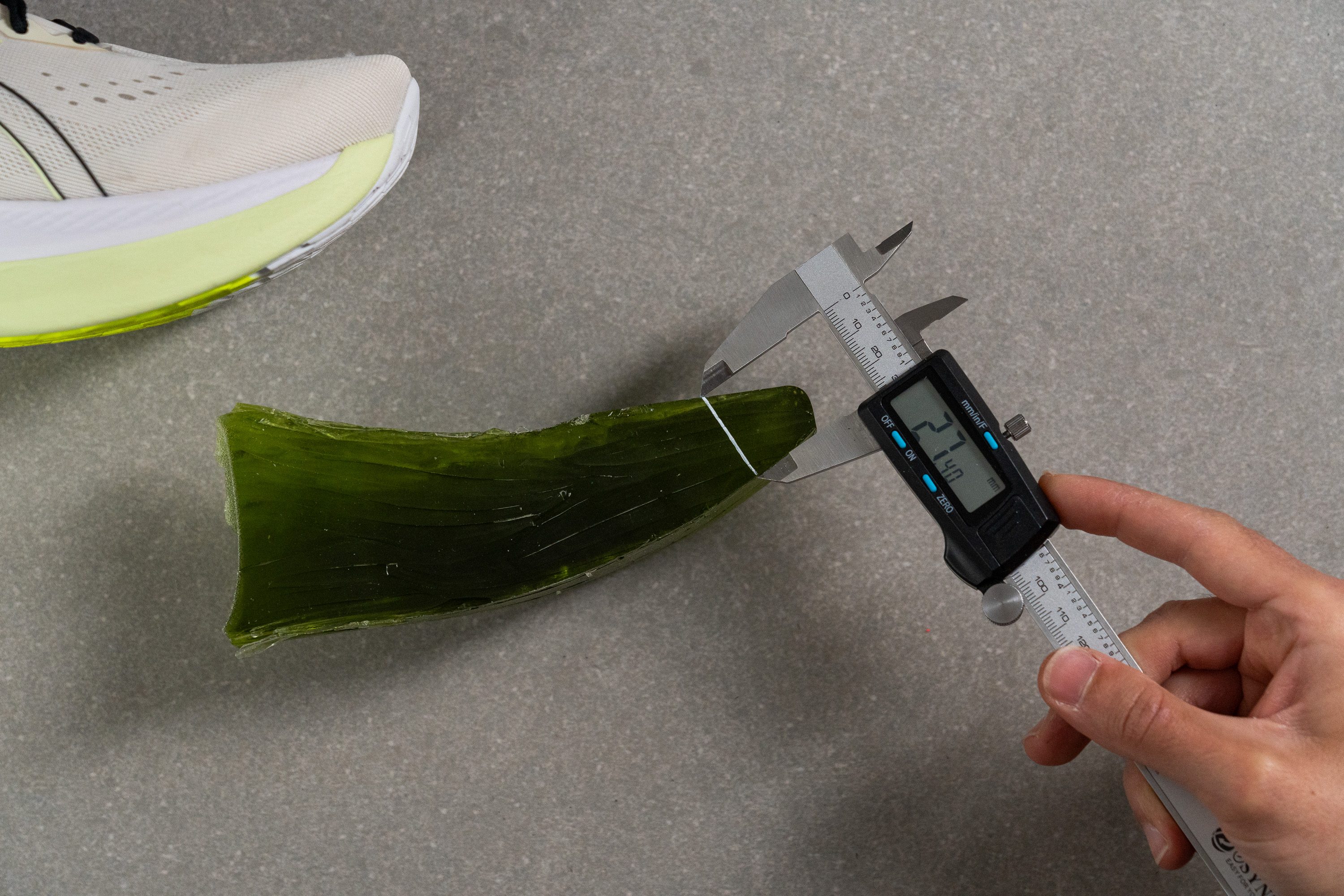
| Glideride Max | 27.4 mm |
| Average | 27.1 mm |
Traction / Grip
Traction test
We discovered that the ASICS Glideride Max crushed our wet-road grip test, earning a standout 0.78. That’s one of the highest scores we’ve measured—definitely weather-ready, and built for slippery conditions despite having so much exposed foam.
With a score this strong, the Hybrid ASICSGRIP rubber delivers rain-day confidence and easily outgrips many pricier rivals. And naturally, it provides claw-like traction on dry roads too.
| Glideride Max | 0.78 |
| Average | 0.48 |
Outsole design
Just as the Glideride Max blends elements from the Novablast and Nimbus, its outsole features Hybrid ASICSGRIP—a fusion of AHAR+ and ASICSGRIP. It’s as if ASICS decided to mix everything into one shoe!
And, no surprise here, the rubber coverage lands right in the middle too. It's neither minimal nor overly generous. If there’s one theme with this shoe, it’s balance across the board...
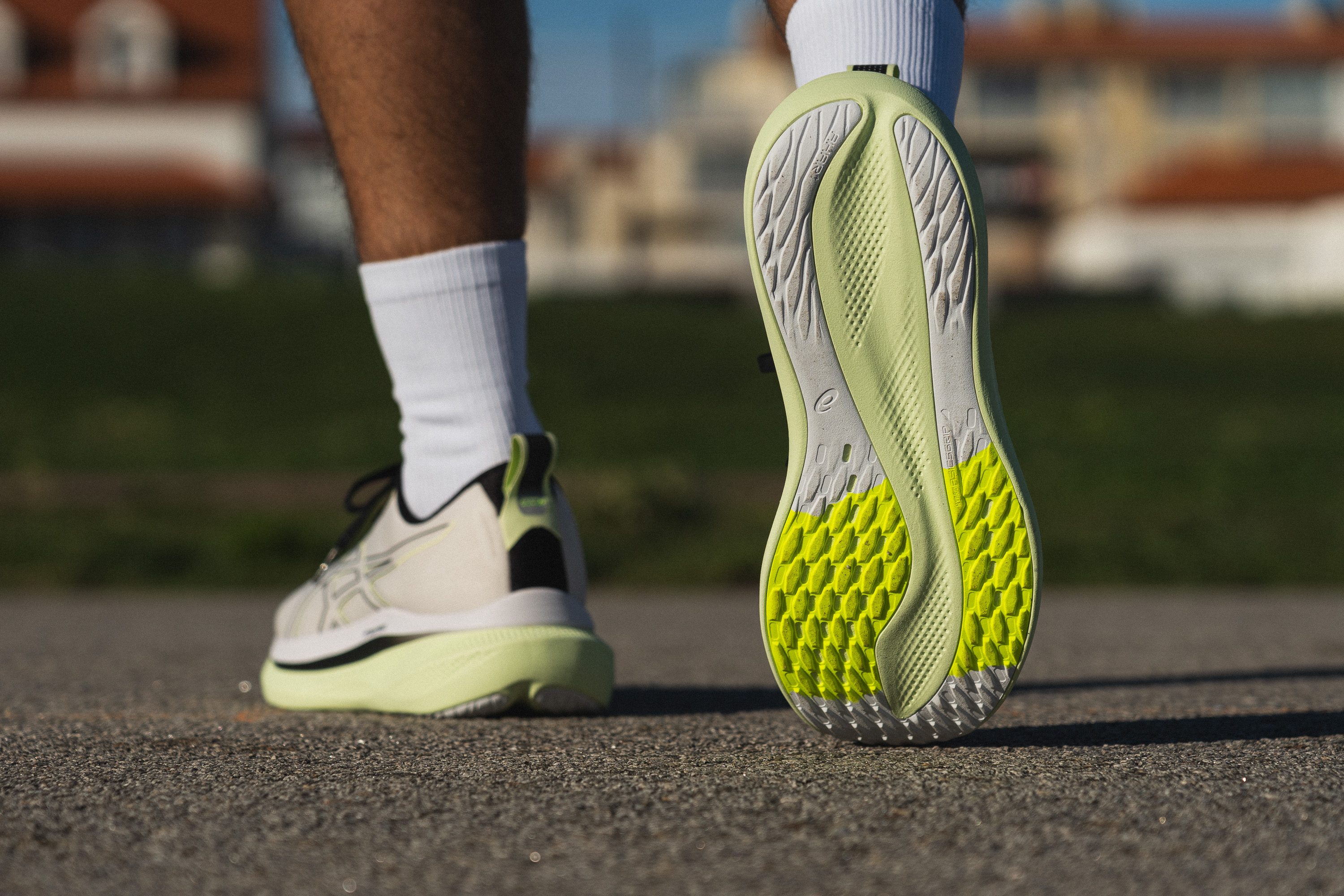
Flexibility / Stiffness
Many daily trainers double as walking shoes for everyday use, but in our view, the Glideride Max isn't the best choice for that. Its towering stack height and rigid build limit flexibility in every direction. Even longitudinally, we had to apply 13.3N to bend it to 30 degrees—an average result but a bit excessive compared to most daily trainers.
We also believe its premium price makes it an expensive option for casual walking when more comfortable, wallet-friendly alternatives exist.
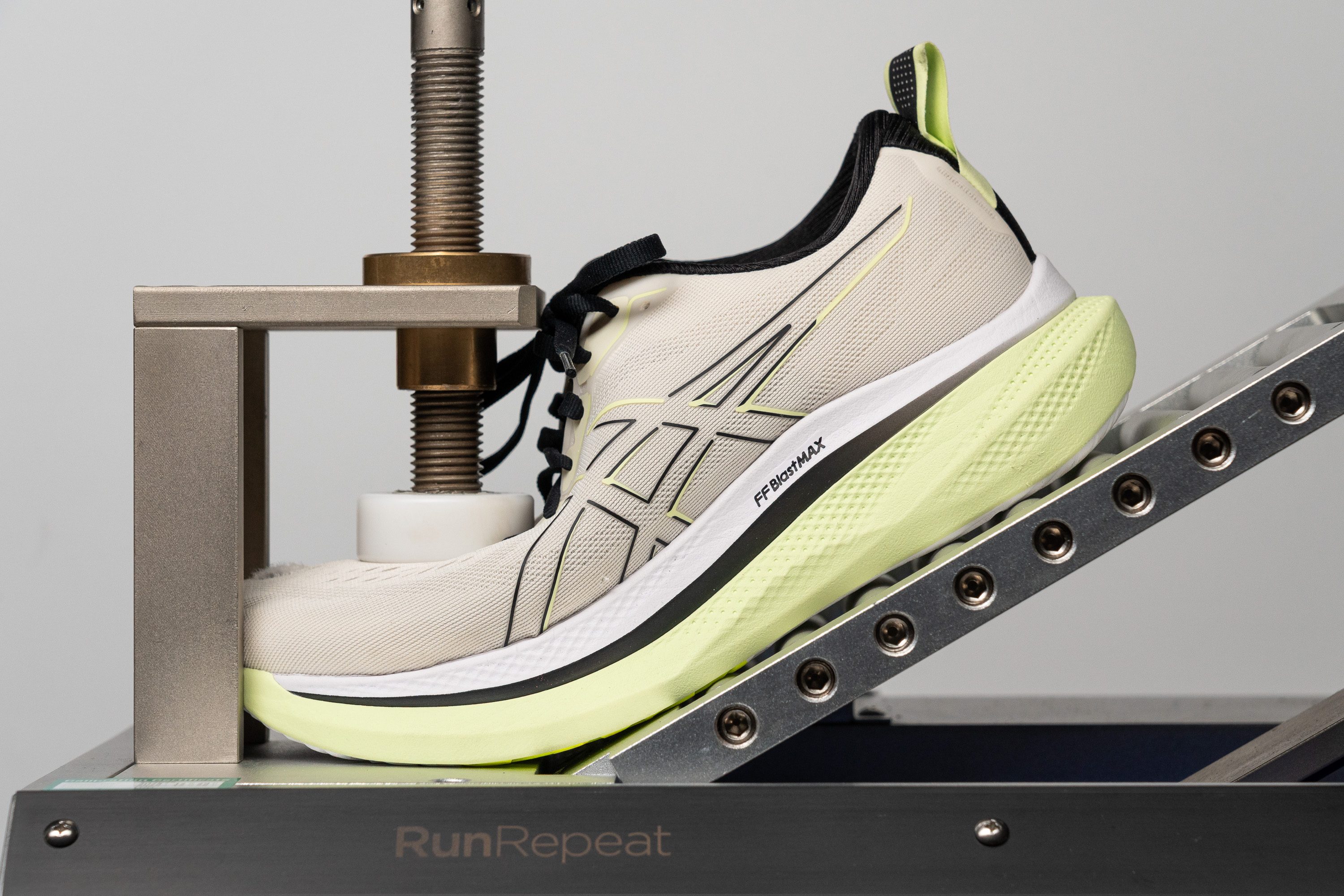
| Glideride Max | 13.3N |
| Average | 15.2N |
Weight
At 9.9 oz or 281g, ASICS did an impressive job keeping this shoe relatively lightweight for its size, and we have to give credit for that. In fact, with its towering heel stack, it feels even lighter than the numbers suggest!
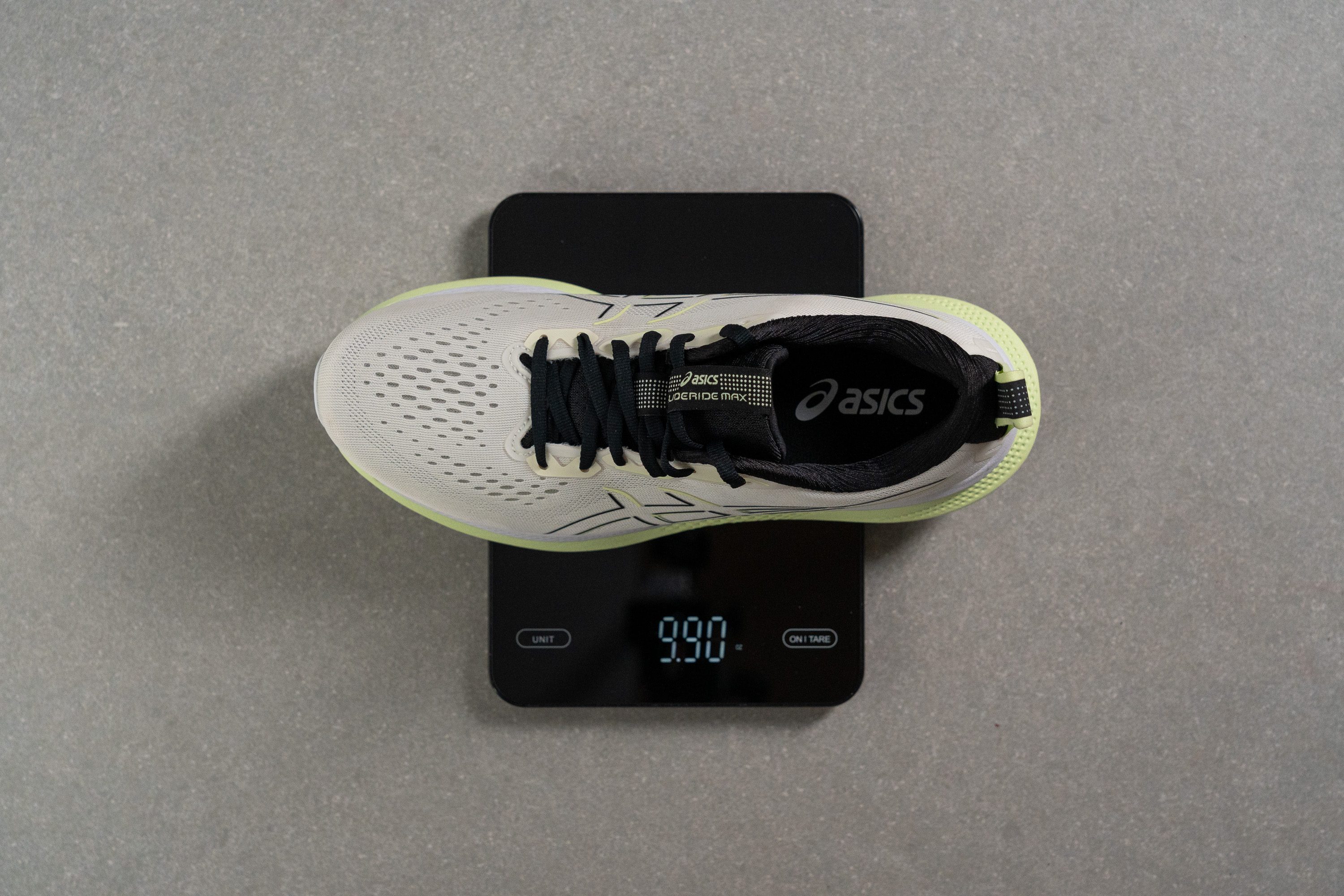
| Glideride Max | 9.9 oz (281g) |
| Average | 9.3 oz (264g) |
Breathability
The upper of the Glideride Max feels smooth to the touch, and during our test runs, we found the ventilation to be sufficient. However, we wanted to put it through a more controlled evaluation to see how it performs under stress.
When we ran our smoke test, we observed moderate airflow—not exactly a game-changer, but decent enough for everyday use. We ultimately rated it a 3/5, which raises concerns for scorching summer days but should be acceptable for most runners in mild conditions.
Inspecting the upper, we discovered the reason behind its breathability limitations. ASICS prioritised structure over ventilation, designing a denser upper that allows air to escape primarily through the toebox while reinforcing the rest of the shoe.
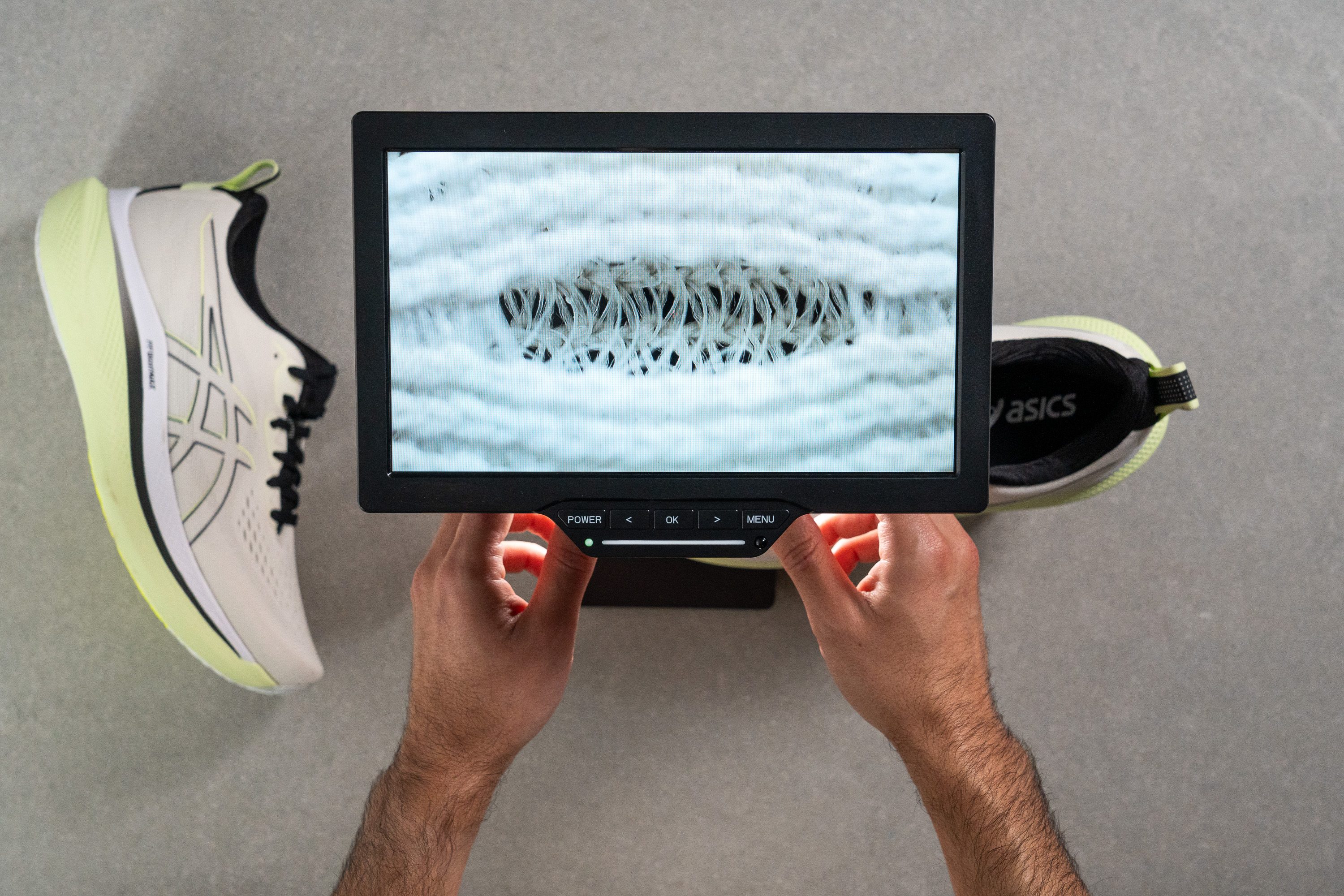
For a shoe at this price point, some runners may have expected a premium knit upper.
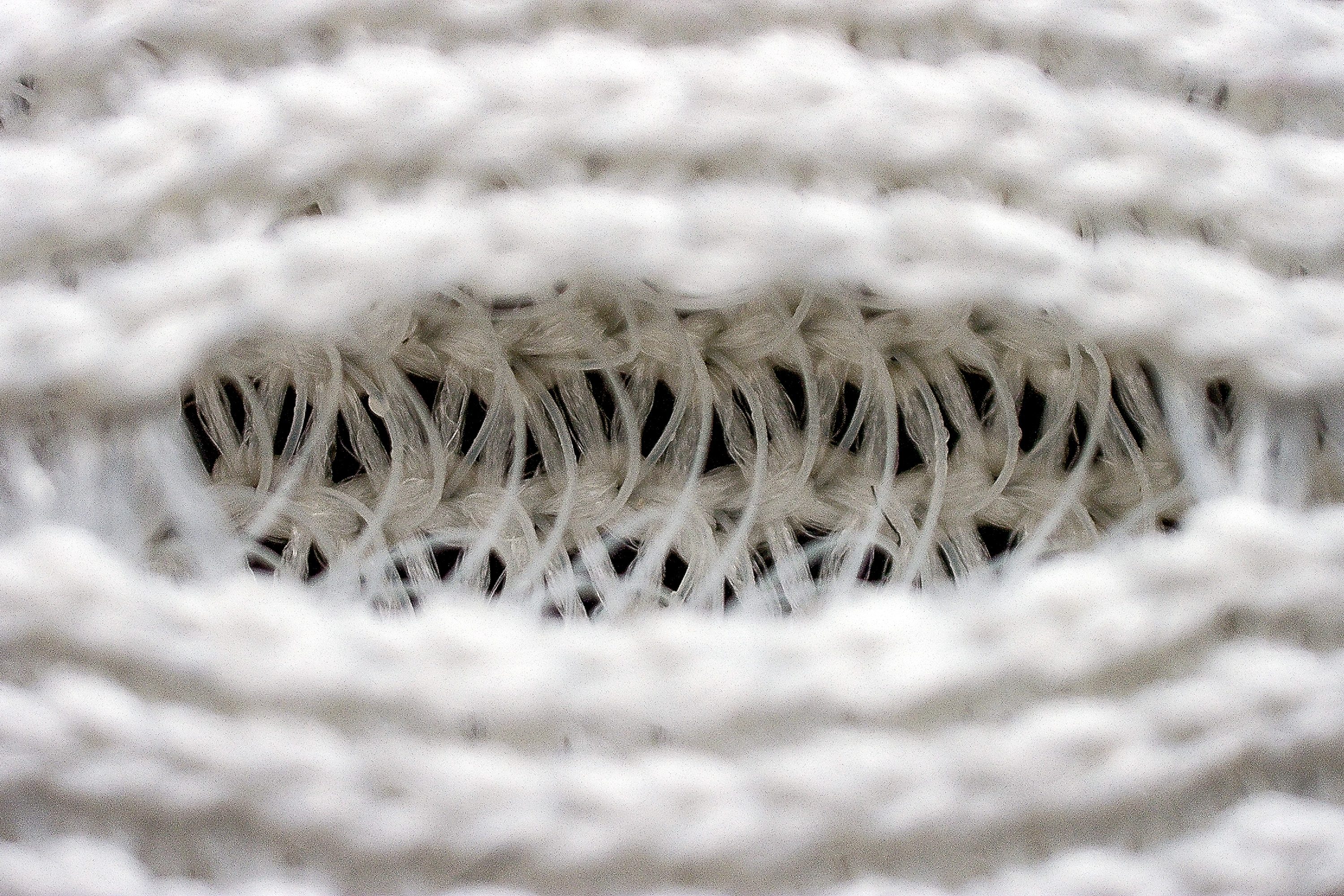
Instead, ASICS opted for a standard engineered mesh with perforations—though a secondary layer partially blocks airflow, limiting its cooling effect.
That said, we believe the upper strikes a reasonable balance between comfort and durability. While not exceptional in breathability, it remains lightweight and well-padded, making it a solid choice for runners who don’t need maximum airflow.
| Glideride Max | 3 |
| Average | 3.7 |
Stability
Lateral stability test
The Glideride Max incorporates multiple stability-enhancing elements, including midsole sidewalls, an EVA plate, a rigid build, and a broad heel platform. However, in our experience, it remains best suited for neutral runners, and those needing extra support might find a better match in a stability-focused shoe like the Saucony Hurricane 24.
Torsional rigidity
With its towering stack height and EVA plate, the Glideride Max delivers maximum torsional rigidity, scoring a solid 5/5.
This enhances stability but may deter runners looking for a natural, more flexible ride—this shoe is anything but that.
| Glideride Max | 5 |
| Average | 3.5 |
Heel counter stiffness
The heel is remarkably stiff, earning another 5/5. That's comparable to stability shoes, which caught us by surprise.
What we mean is, with over 44 mm in the heel, some reinforcement is expected, but this level of rigidity might be a bit excessive.
| Glideride Max | 5 |
| Average | 2.9 |
Midsole width - forefoot
Coming from stability-focused design choices, we expected an incredibly wide forefoot, but instead, we measured an average 113.8 mm—more in line with a budget-friendly daily trainer than a max-cushioned stability shoe.
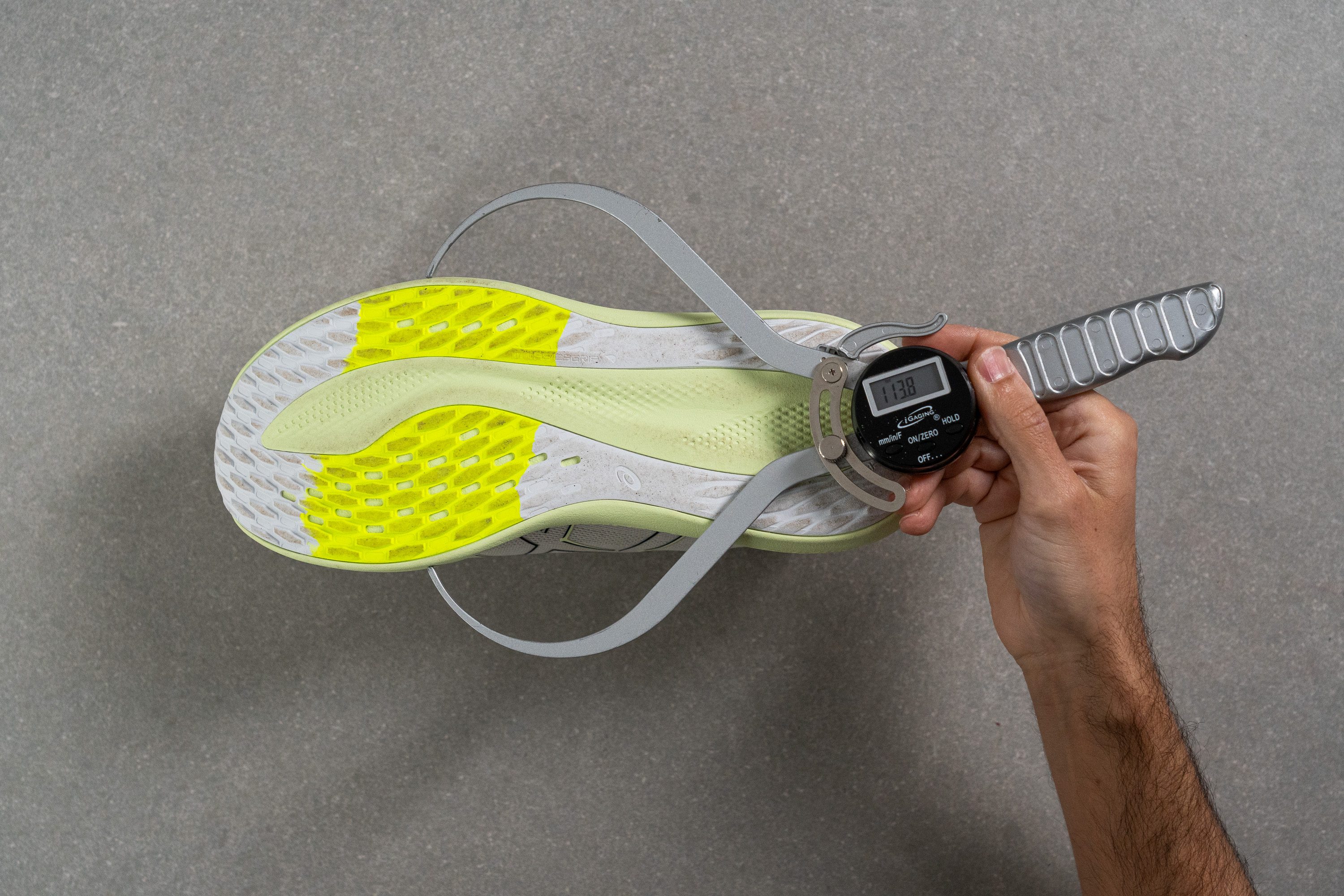
| Glideride Max | 113.8 mm |
| Average | 114.3 mm |
Midsole width - heel
On the flip side, the heel is notably wide at 95.7 mm, reinforcing what we've suspected throughout our testing—this shoe is clearly designed with heel strikers in mind!
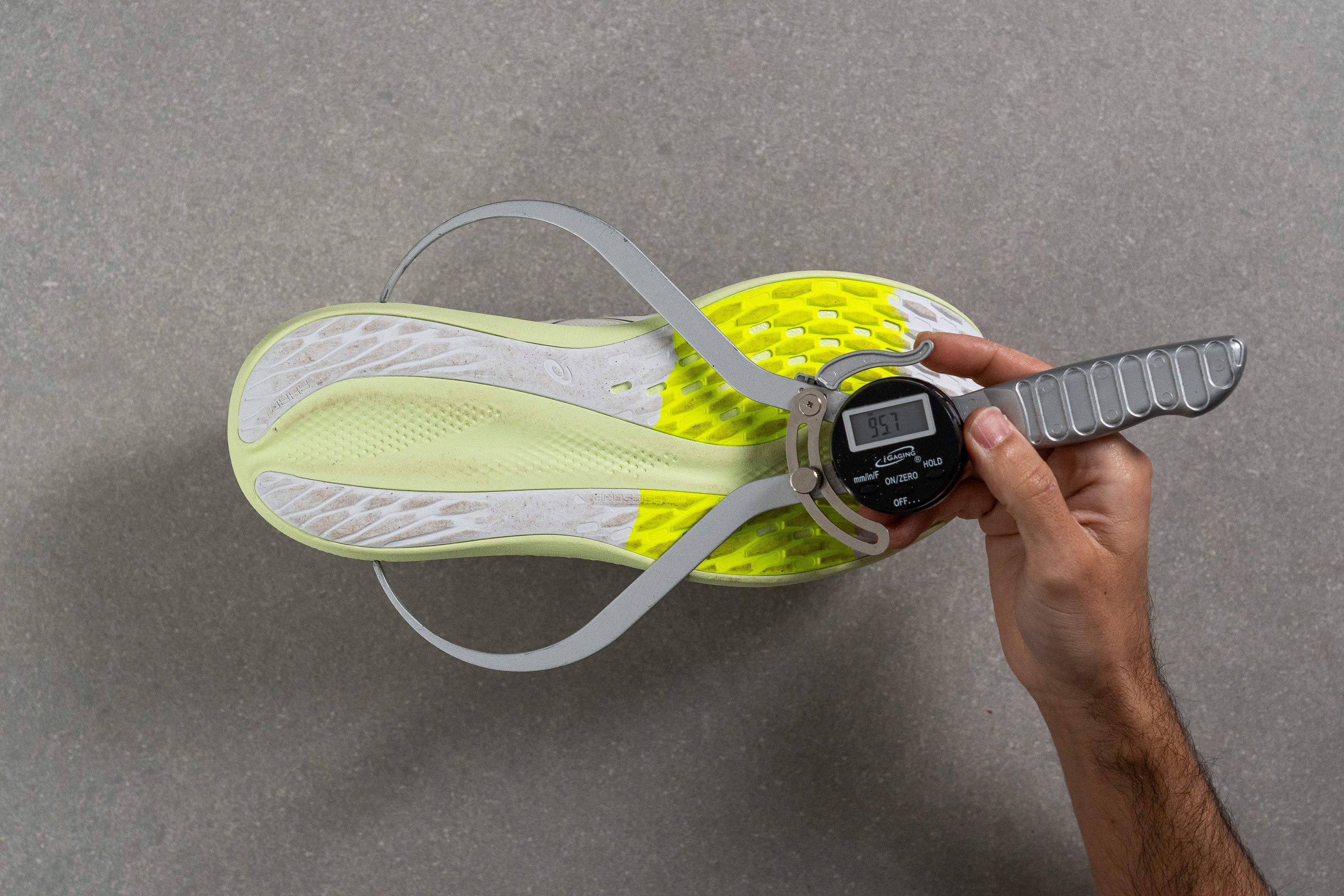
| Glideride Max | 95.7 mm |
| Average | 90.7 mm |
Durability
Toebox durability
We were somewhat disappointed with our first durability test.
Uppers that score 3/5 in breathability typically hold up better than the 2/5 result the Glideride Max received in our first Dremel challenge. There’s definitely room for improvement here!
| Glideride Max | 2 |
| Average | 2.6 |
Heel padding durability
Fortunately, the Glideride Max performed significantly better in the heel, scoring above average with a solid 4/5. That’s great news for runners who tend to wear down this area quickly.
| Glideride Max | 4 |
| Average | 3.4 |
Outsole hardness
Just as the Glideride Max blends elements from the Novablast and Nimbus, its outsole features Hybrid ASICSGRIP—a fusion of AHAR+ and ASICSGRIP. It’s as if ASICS decided to mix everything into one shoe!

We measured a fairly standard hardness of 80.5 HC, which aligned well with its grip—good but not outstanding. And, no surprise here, the rubber coverage lands right in the middle too—neither minimal nor overly generous. If there’s one theme with this shoe, it’s balance across the board...
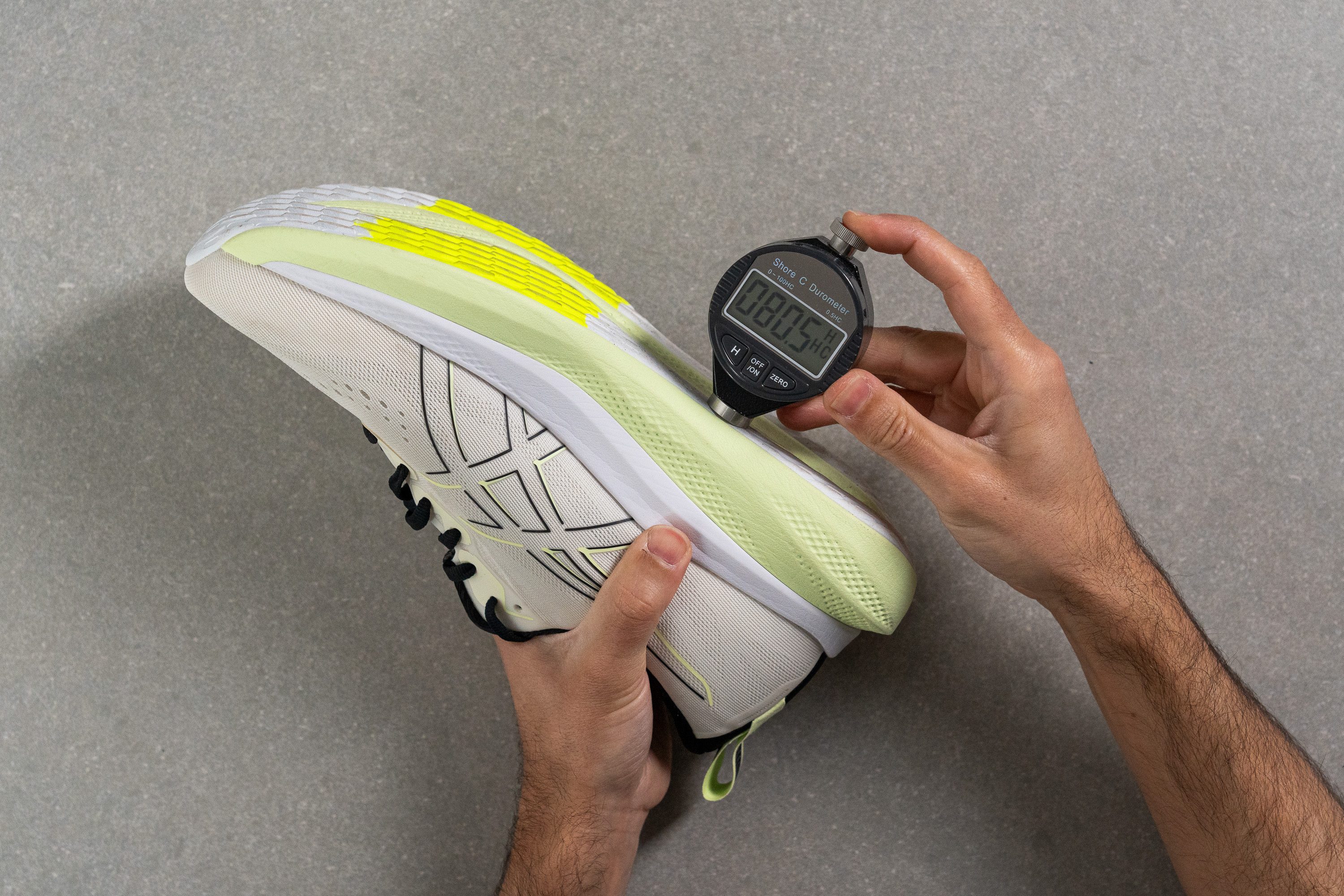
| Glideride Max | 80.5 HC |
| Average | 79.2 HC |
Outsole durability
After testing the Hybrid ASICSGRIP compound with our durometer, we expected decent durability—and that’s exactly what we got. Our evaluation revealed a 0.9 mm tear after lifting the tool, confirming a nice blend of grip and longevity.
| Glideride Max | 0.9 mm |
| Average | 1.1 mm |
Outsole thickness
We were surprised to find a substantial rubber thickness of 4.0 mm.
While this benefits runners aiming for maximum durability, we believe a slightly thinner layer could have reduced weight and enhanced the ride’s fun, lively feel.
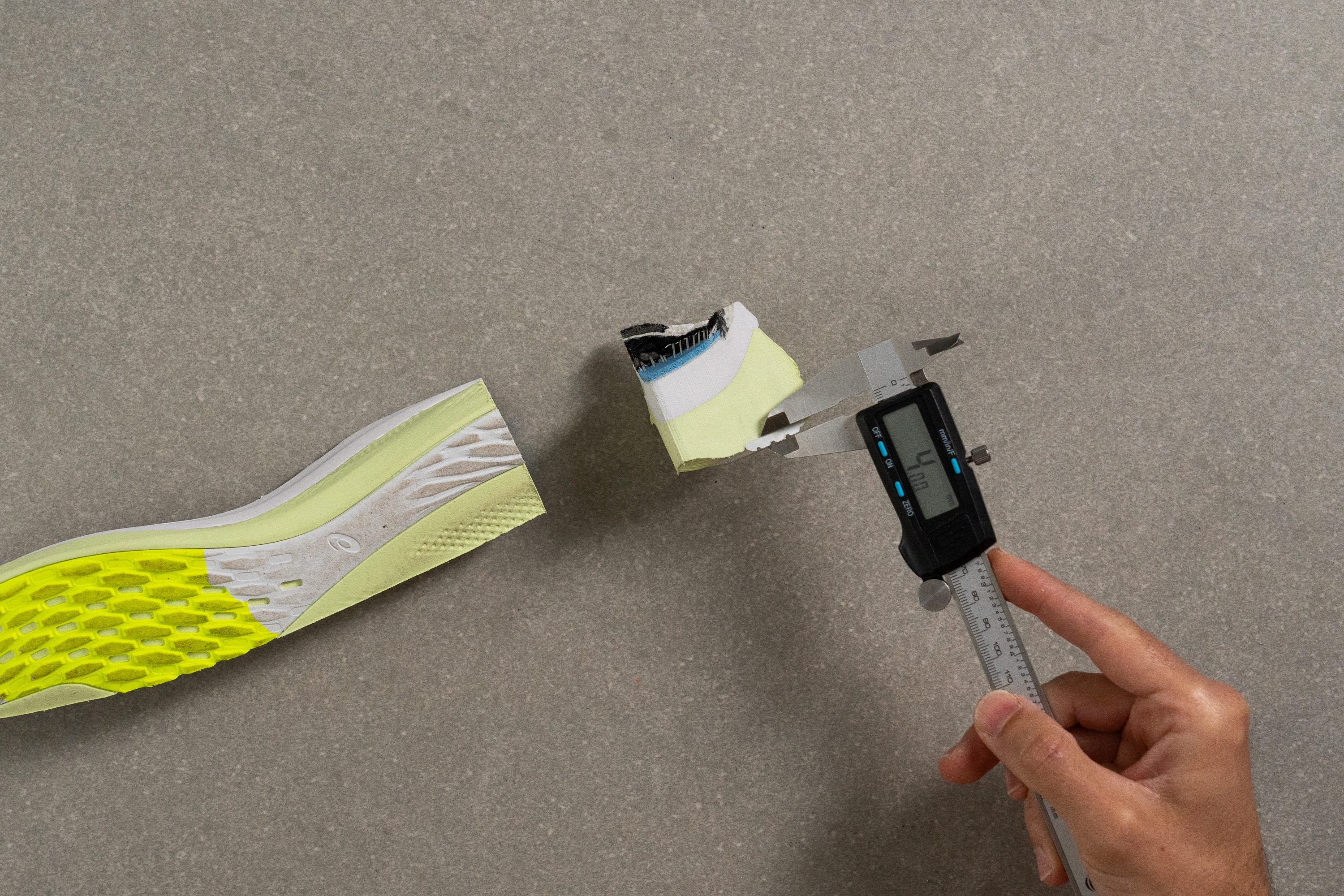
| Glideride Max | 4.0 mm |
| Average | 3.2 mm |
Misc
Insole thickness
The Ortholite X-55 insole comes with moderate cushioning at 4.8 mm.
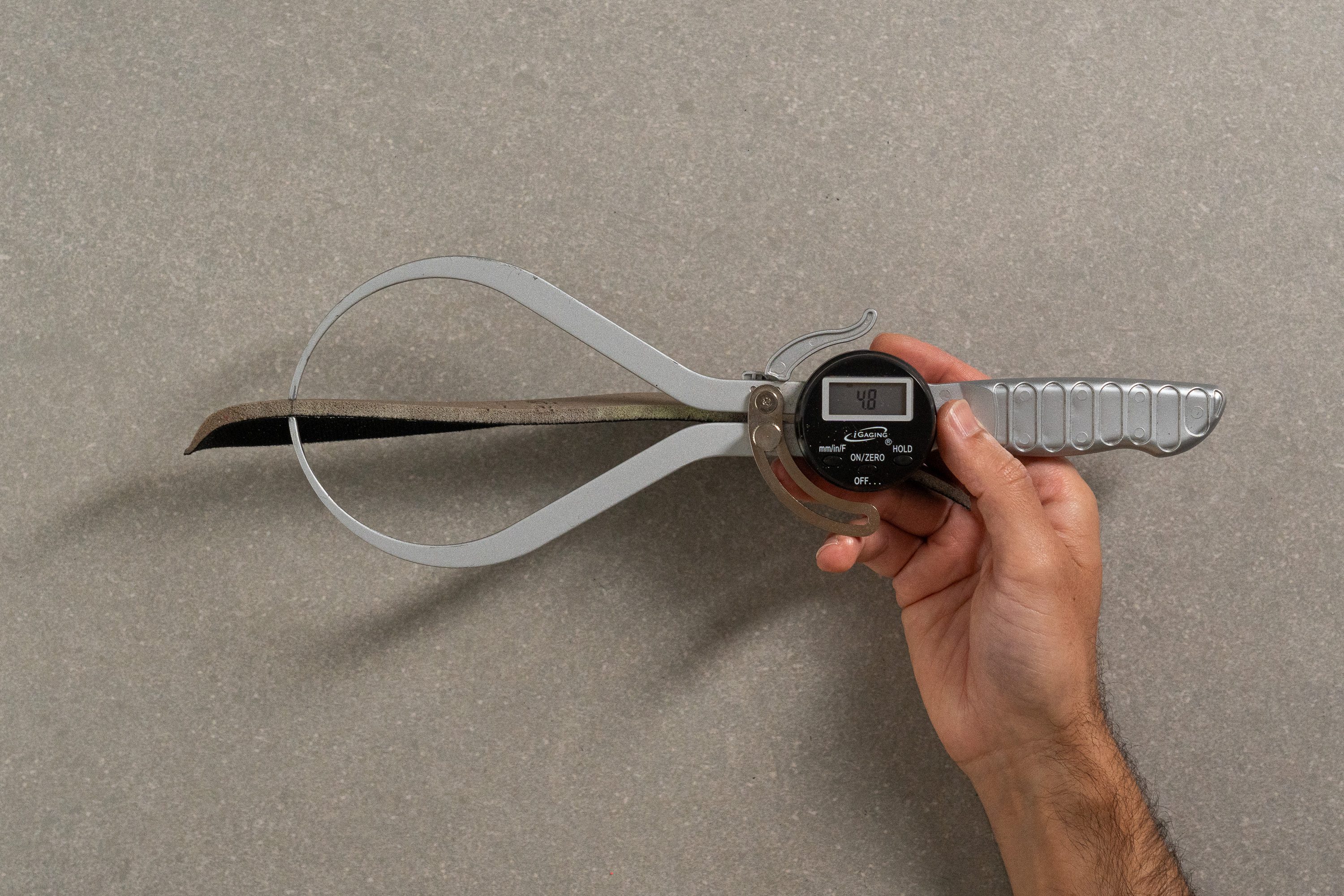
| Glideride Max | 4.8 mm |
| Average | 4.5 mm |
Removable insole
We had no issues swapping the Glideride Max’s insole for custom orthotics.
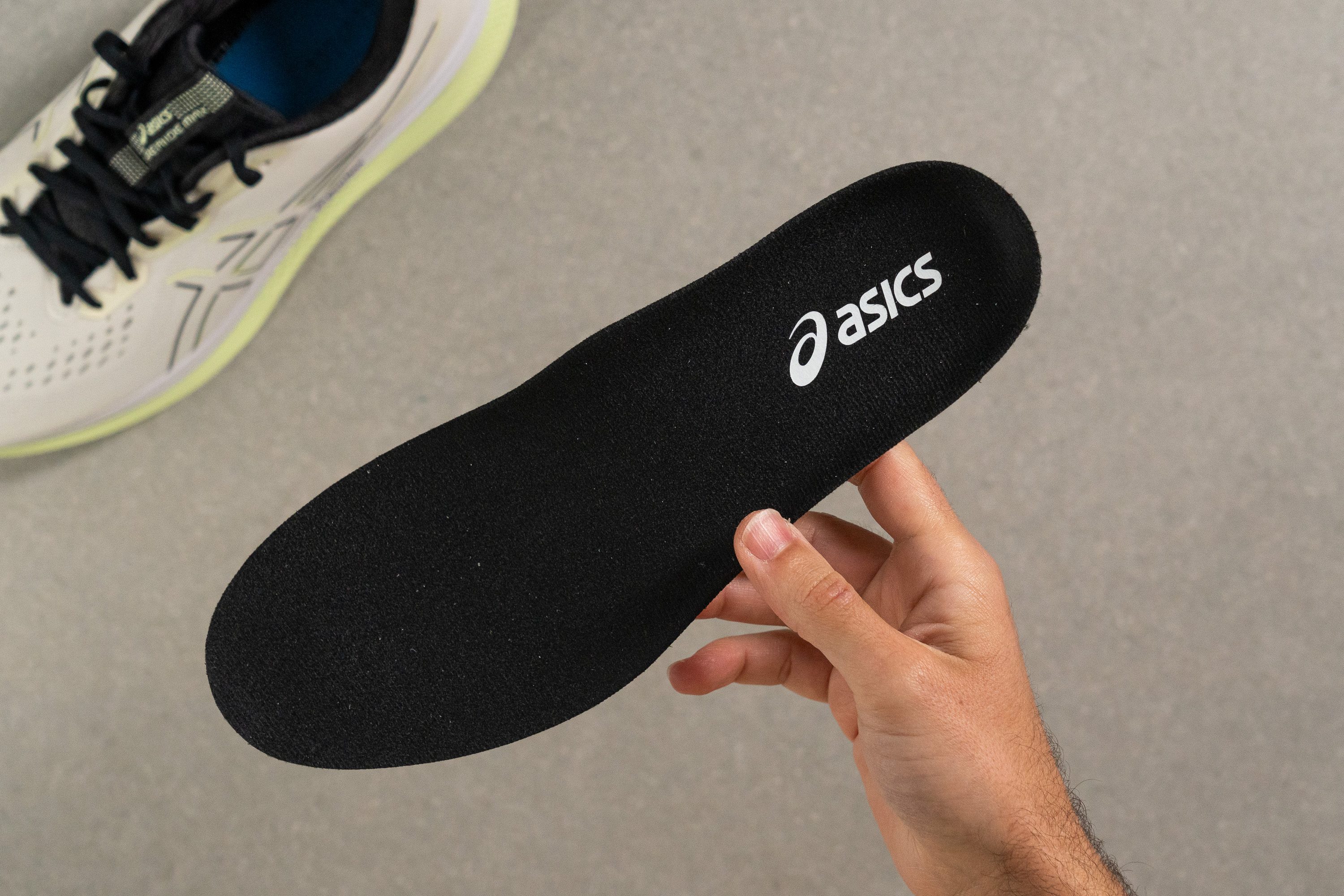
| Glideride Max | Yes |
Midsole softness in cold (%)
Another advantage of FF Blast Max over other FlyteFoam family foams is its improved resistance to cold temperatures—it only became 18% firmer!
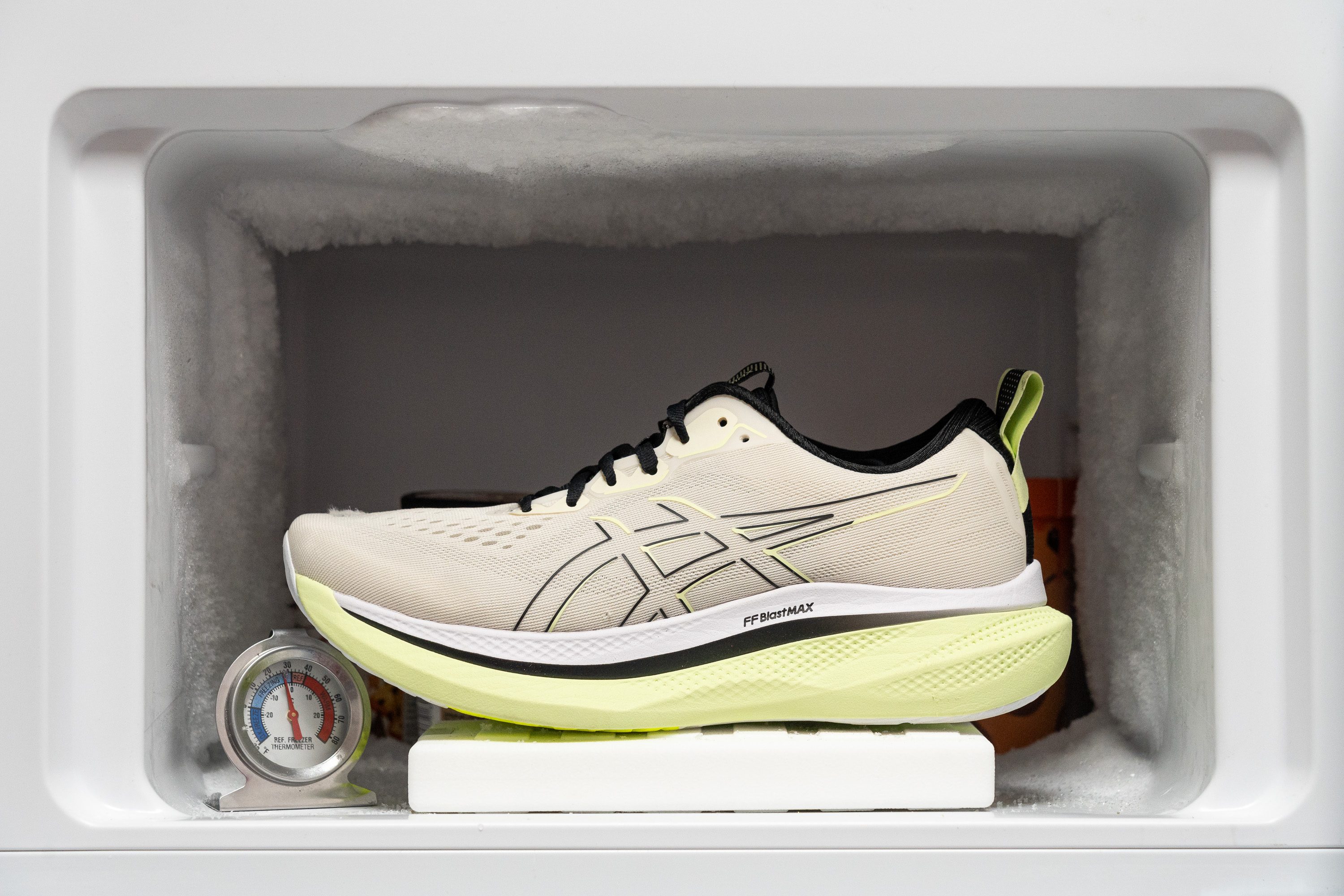
| Glideride Max | 18% |
| Average | 24% |
Reflective elements
Yes! ASICS added reflective elements, improving visibility for those low-light winter runs many runners face.
| Glideride Max | Yes |
Tongue padding
We appreciate that ASICS kept the lacing system simple and effective, using punched eyelets and thin, flat laces that allow for a runner’s knot.
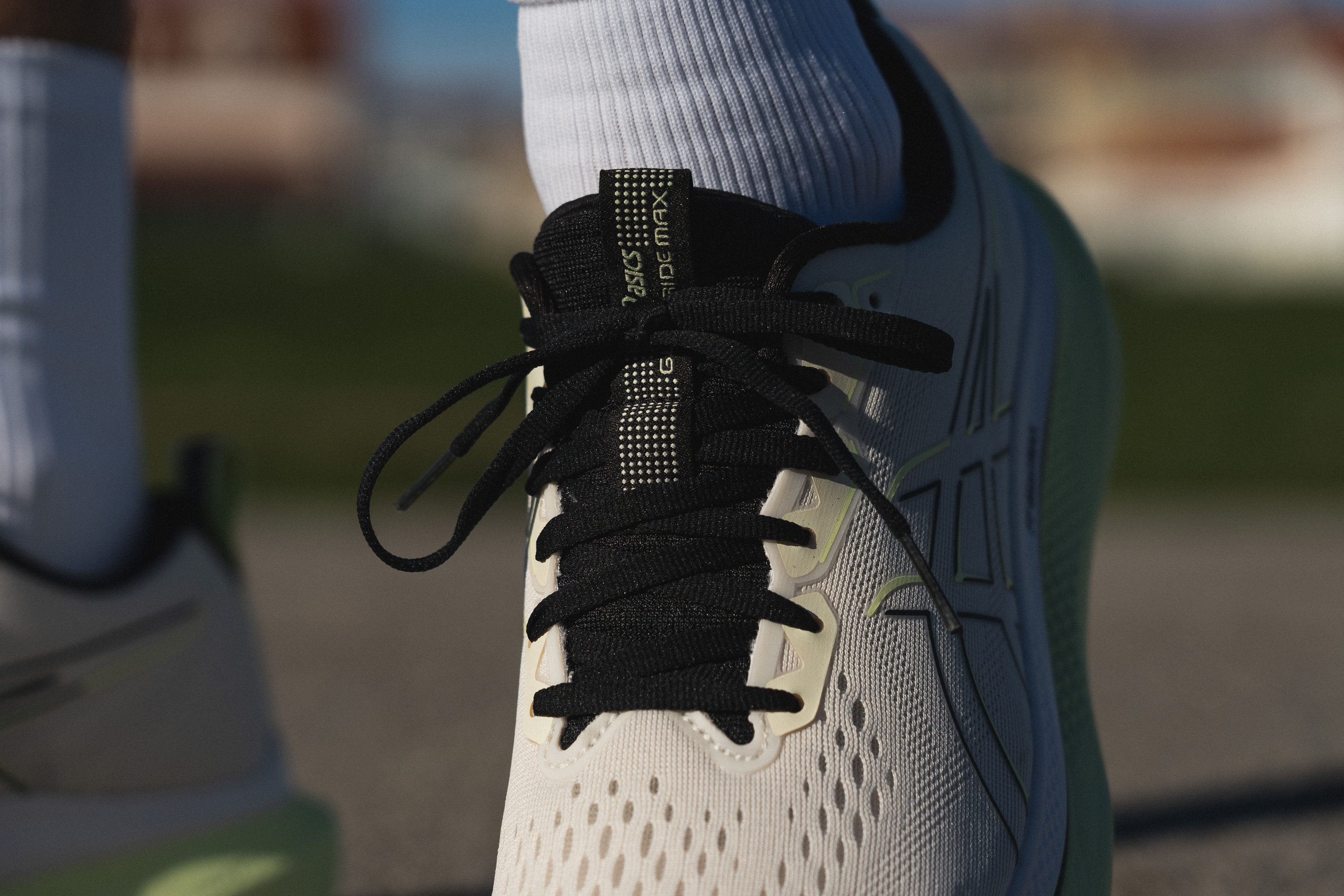
We also liked the Glideride Max’s tongue, which, at 6.0 mm, strikes a well-balanced mix of comfort and weight. Many brands opt for overly-thick padding to create an ultra plush feel, but we believe that anything above 5.0 mm adds bulk without meaningful comfort improvements.
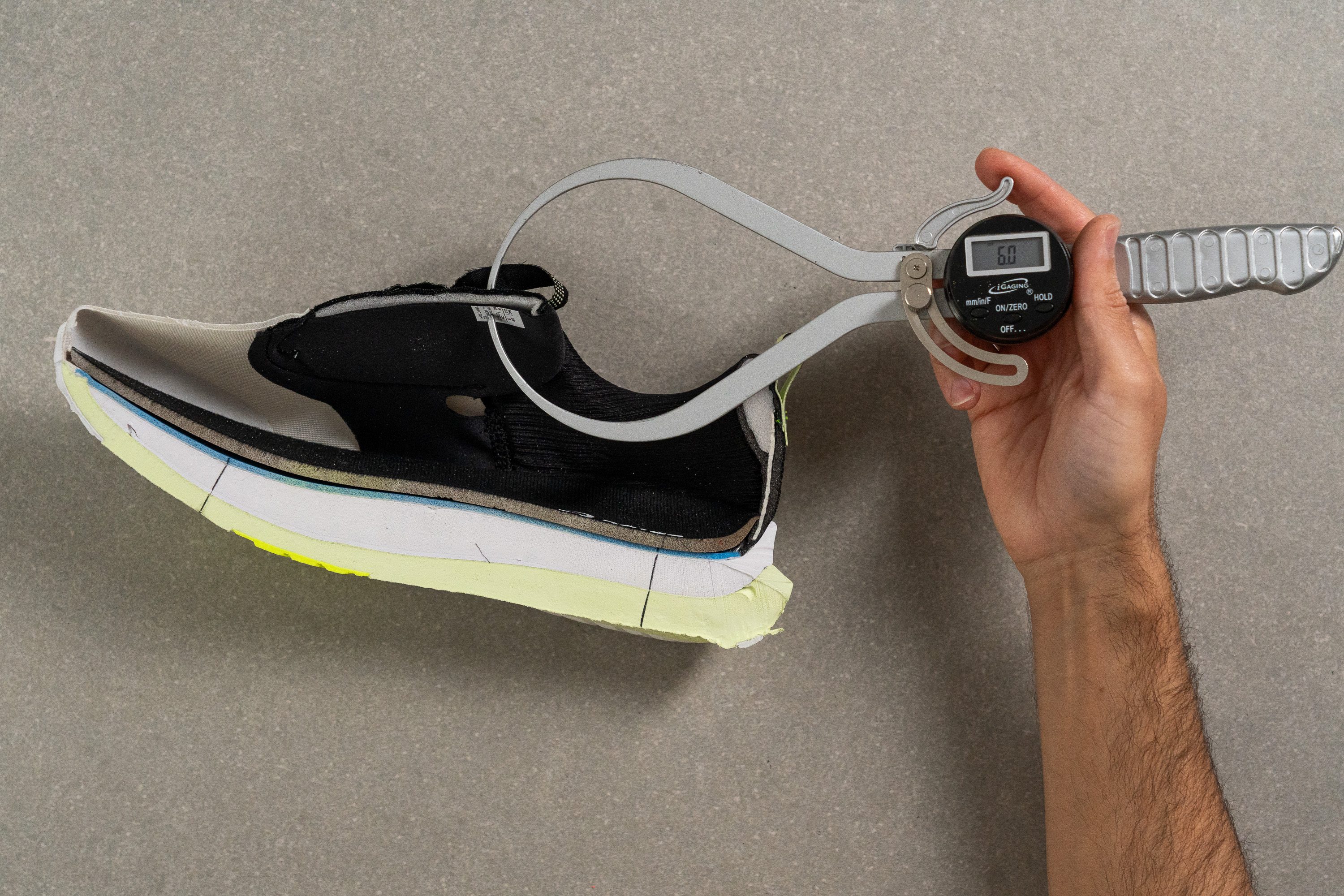
| Glideride Max | 6.0 mm |
| Average | 5.8 mm |
Tongue: gusset type
Priced above most daily trainers, we expected a gusseted tongue, and ASICS delivered.
In our experience, its design provides a snug and comfortable fit, preventing any shifting and ensuring a locked-in feel during runs.

| Glideride Max | Both sides (semi) |
Price
The Glideride Max sits in the premium range of daily trainers, competing with models like the Nike Vomero 17 and the New Balance Fresh Foam X Balos.
In our view, ASICS strategically priced this shoe between the Nimbus and Novablast series to bridge a gap in their lineup that might otherwise push runners toward other brands.
| Glideride Max | $170 |
Heel tab
We found a handy heel pull tab makes it easier to slip into the shoe and achieve a secure heel lockdown.
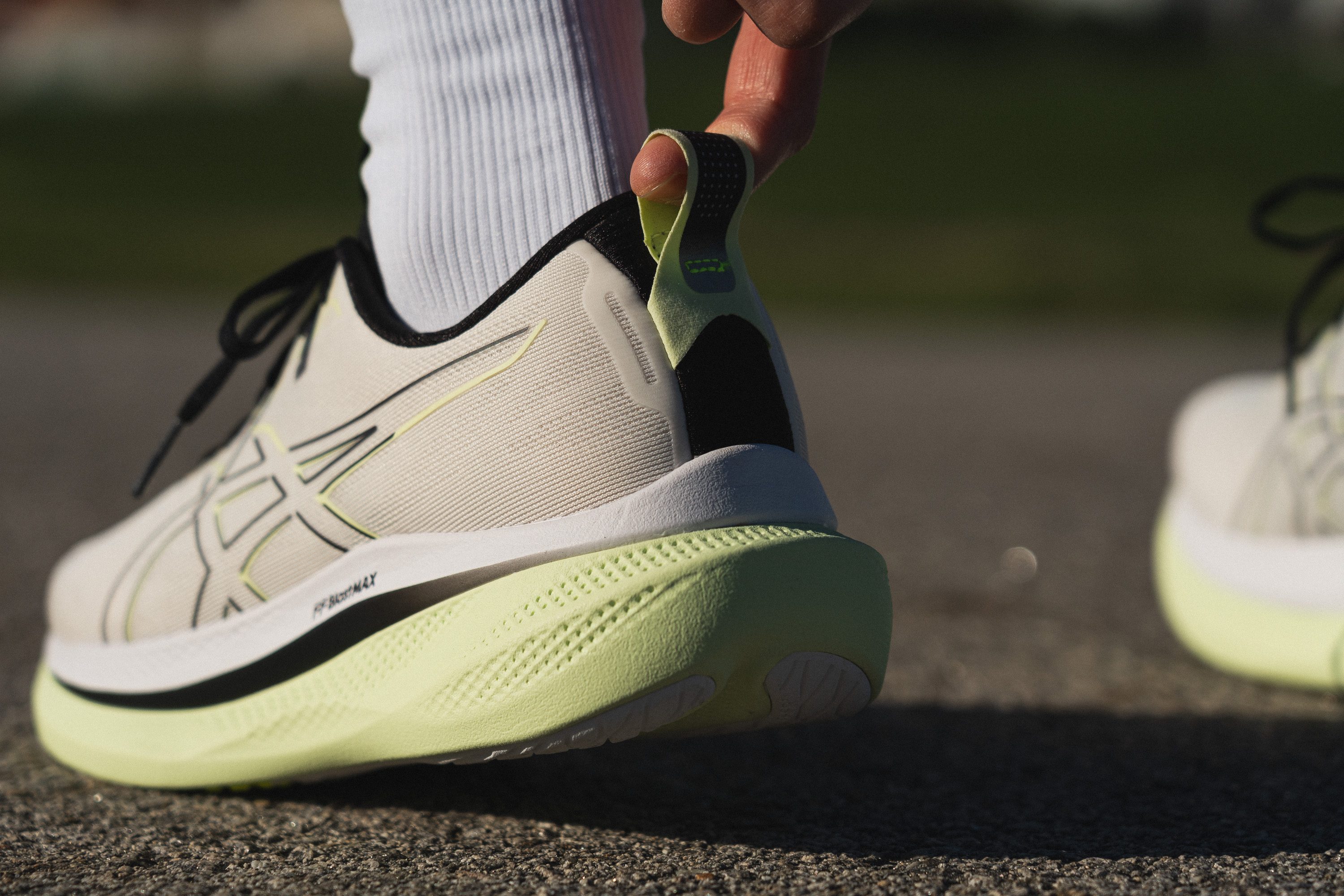
| Glideride Max | Pull tab |

